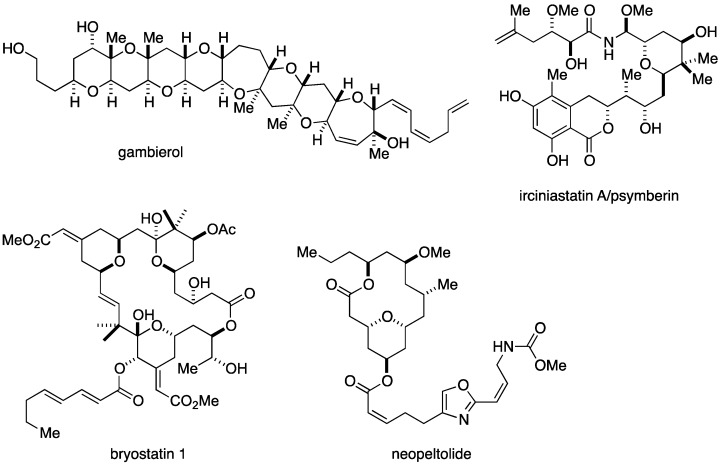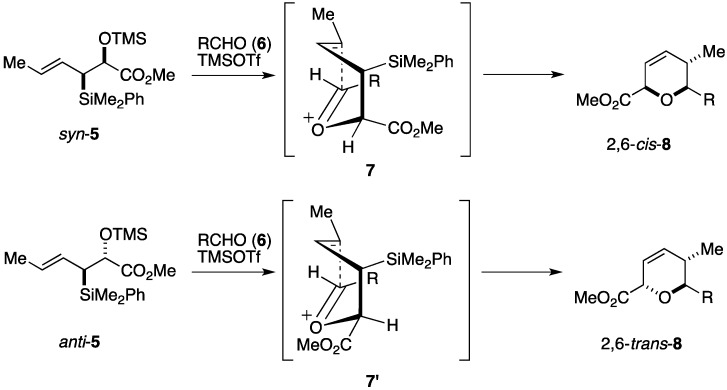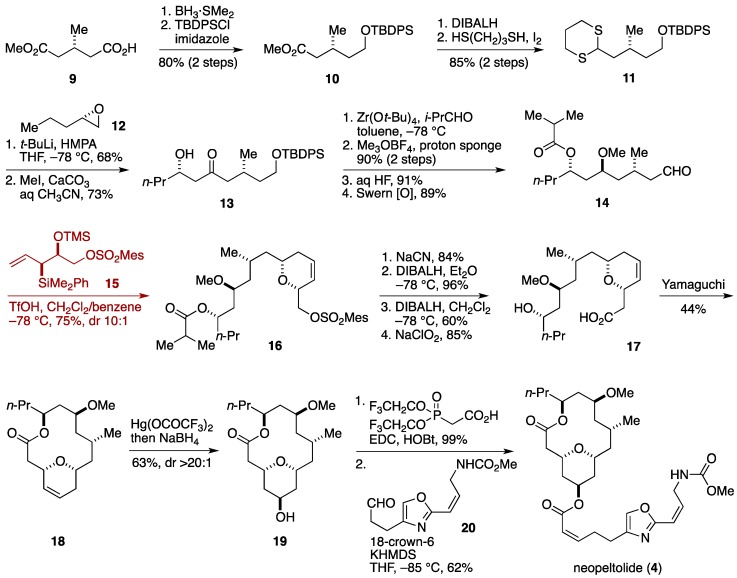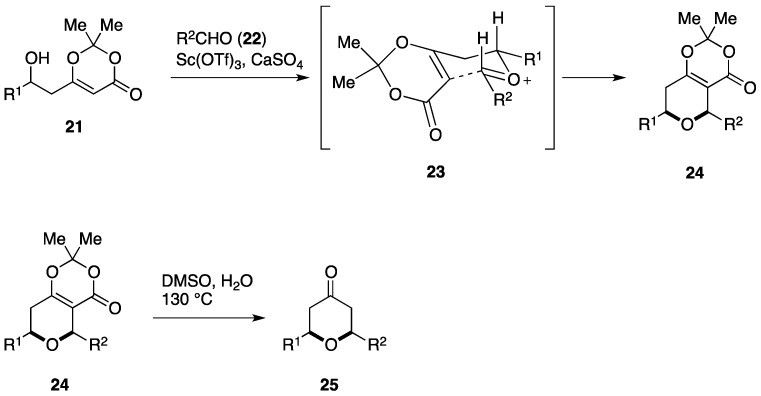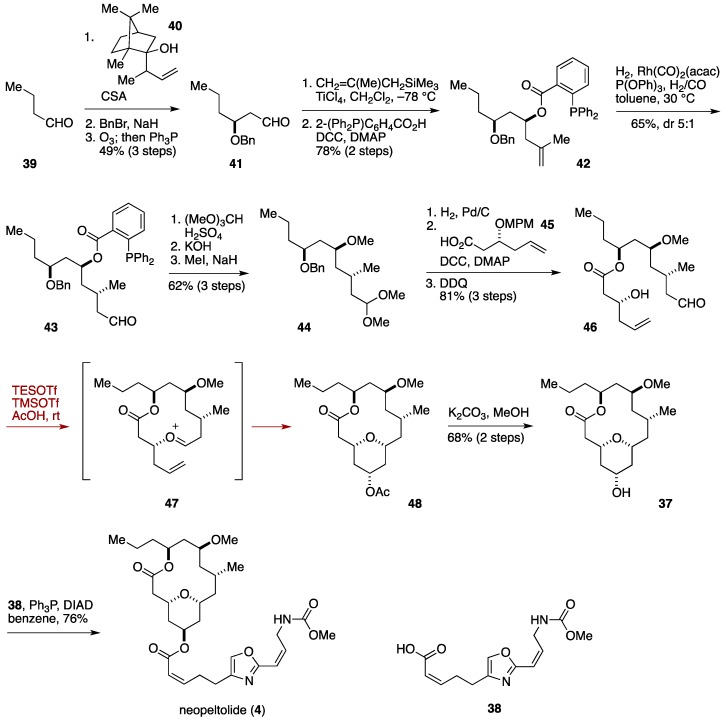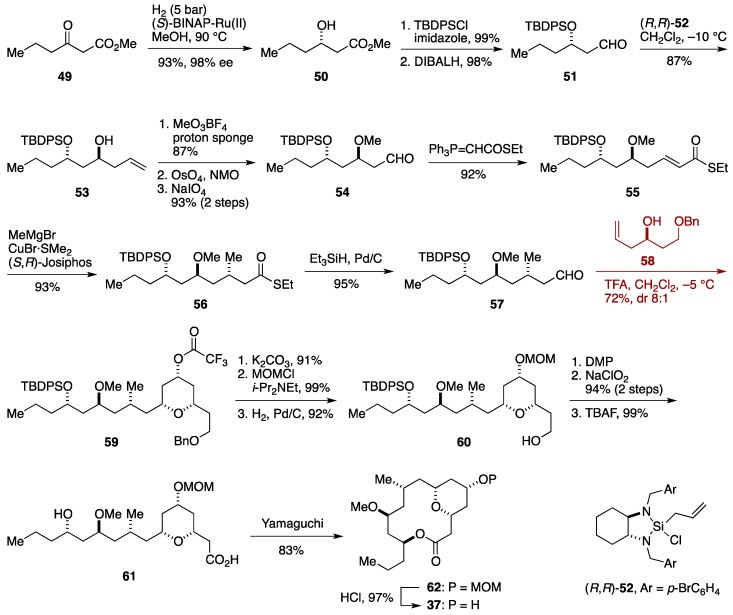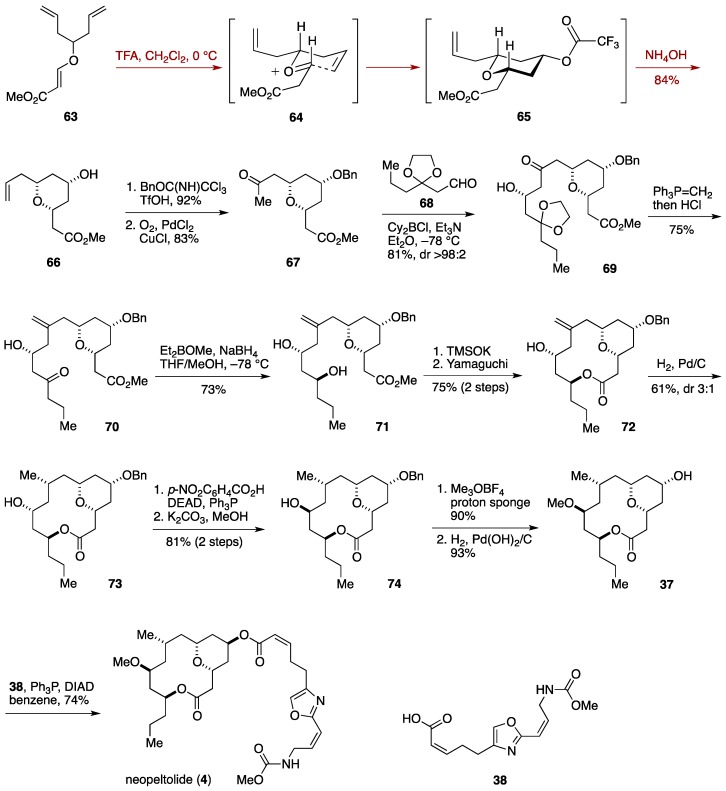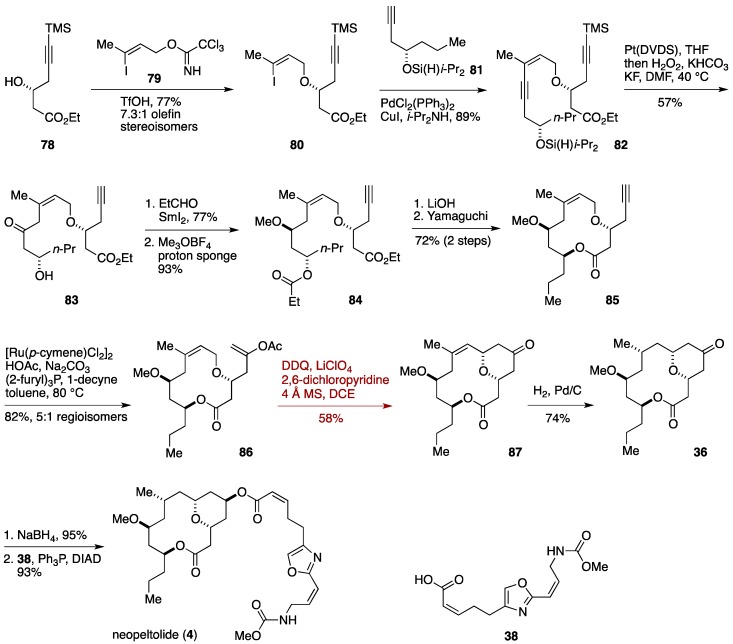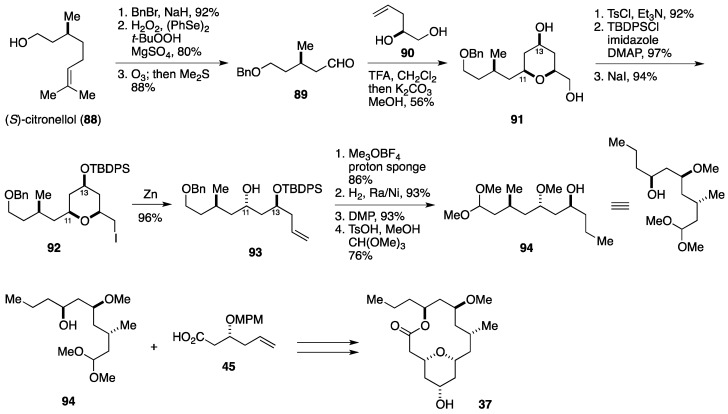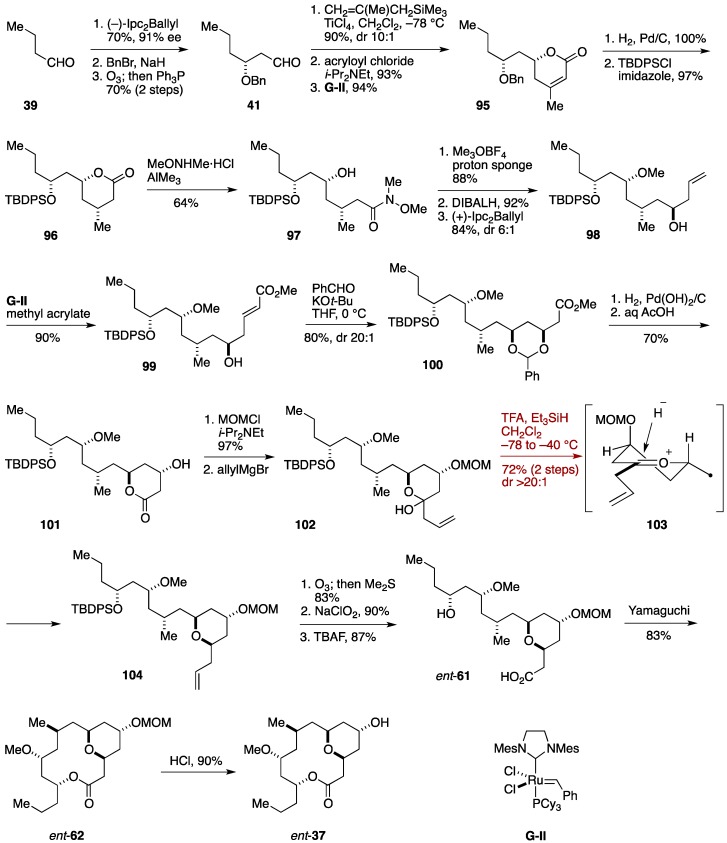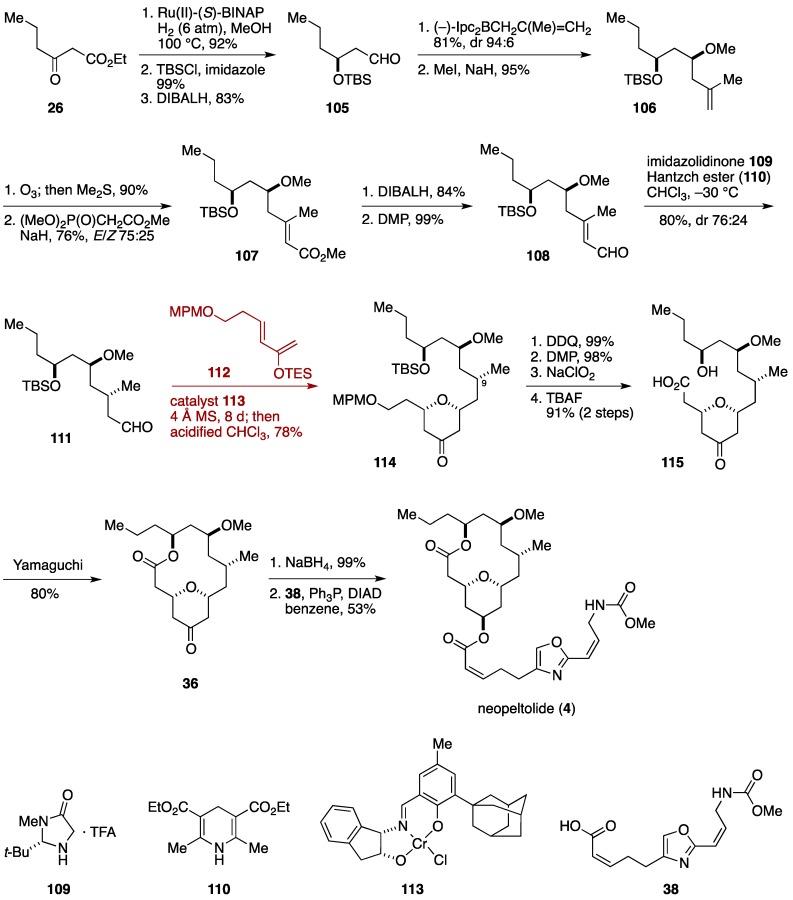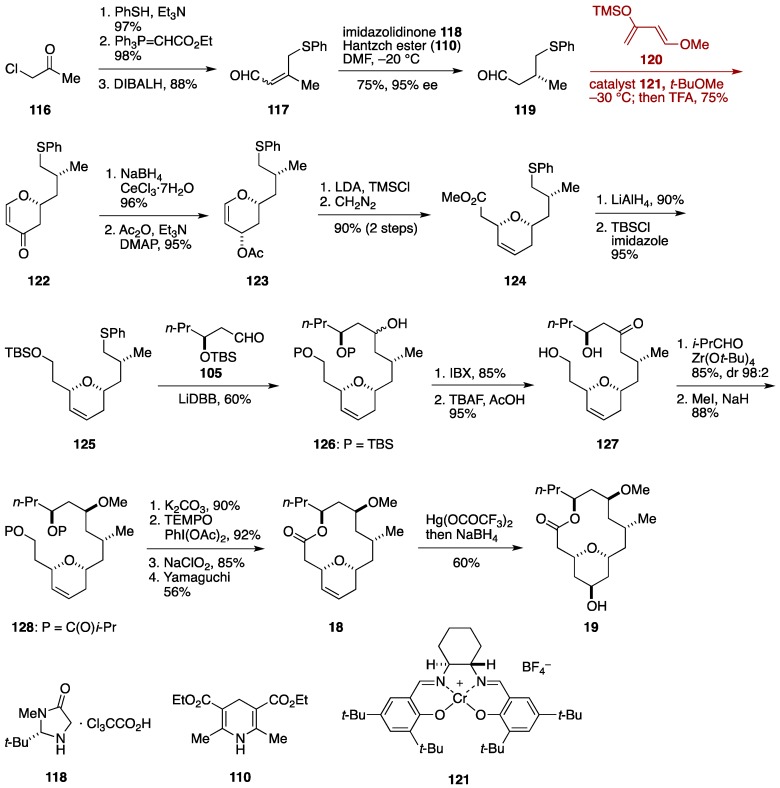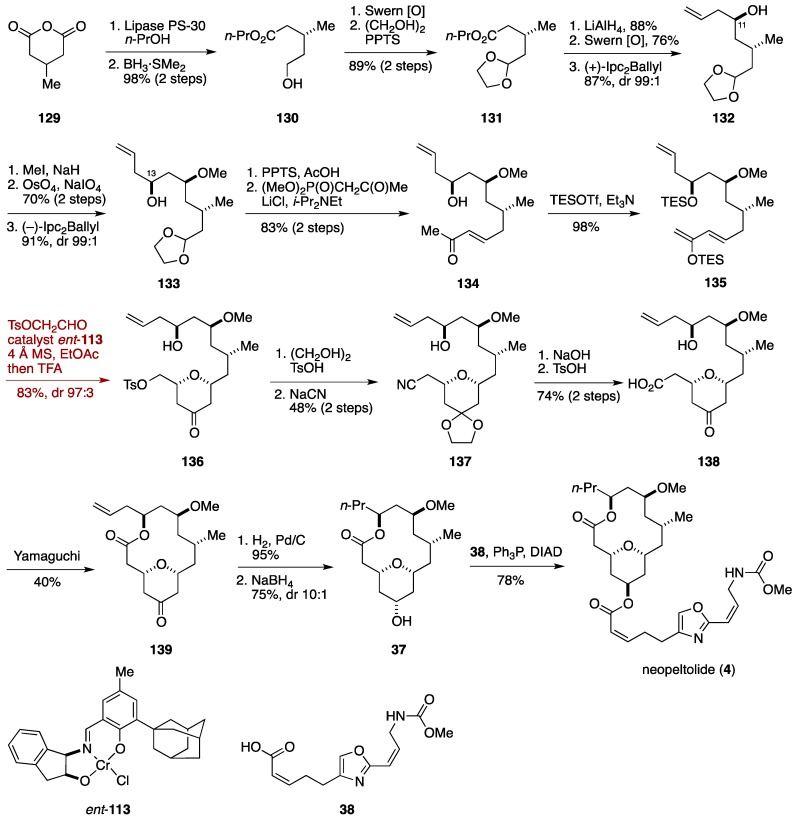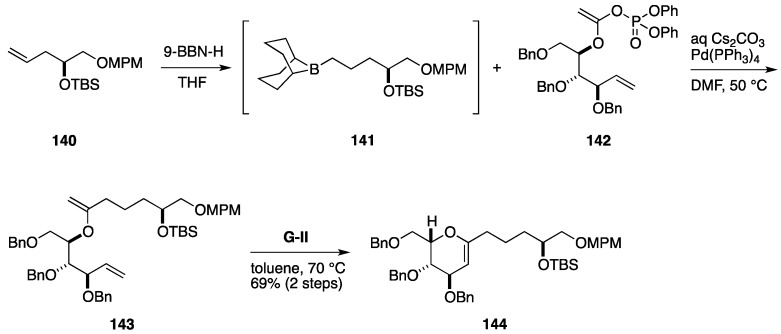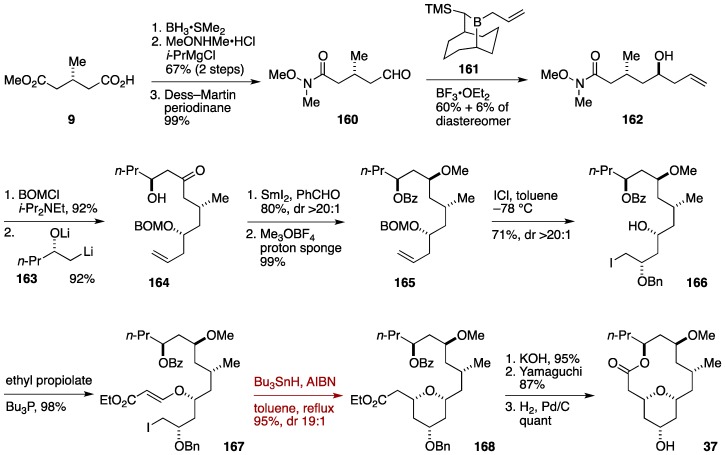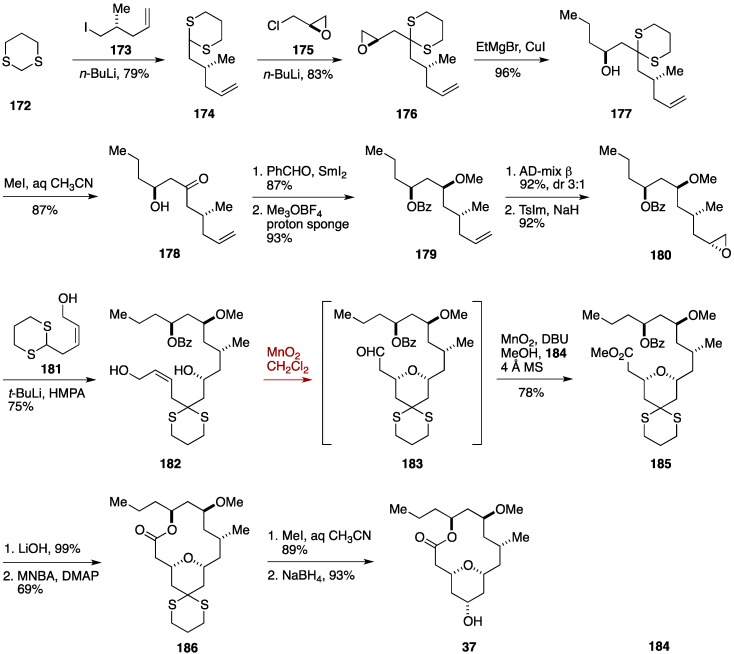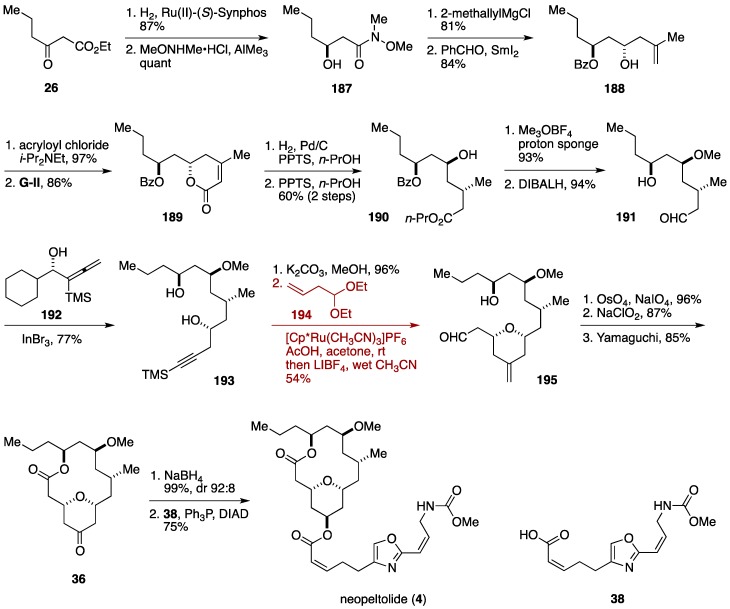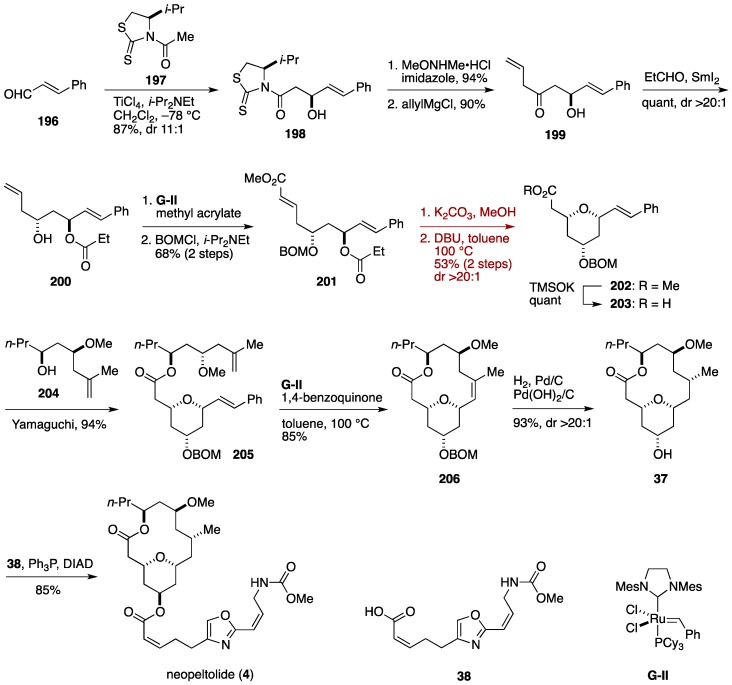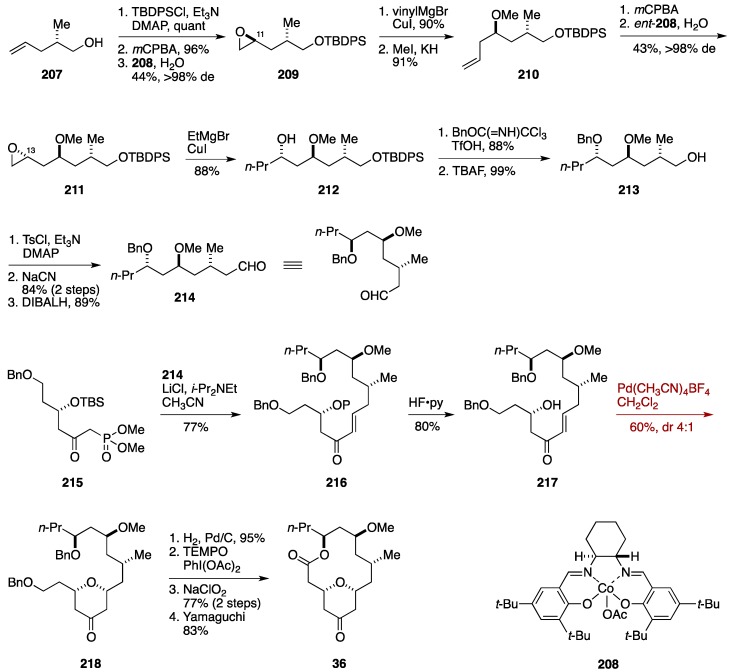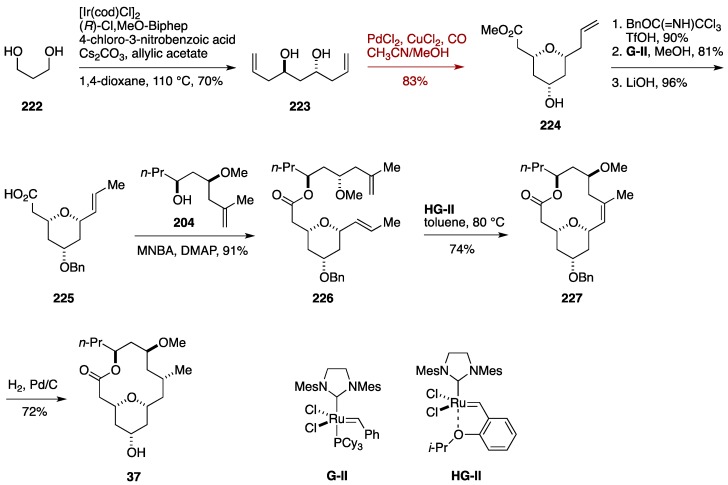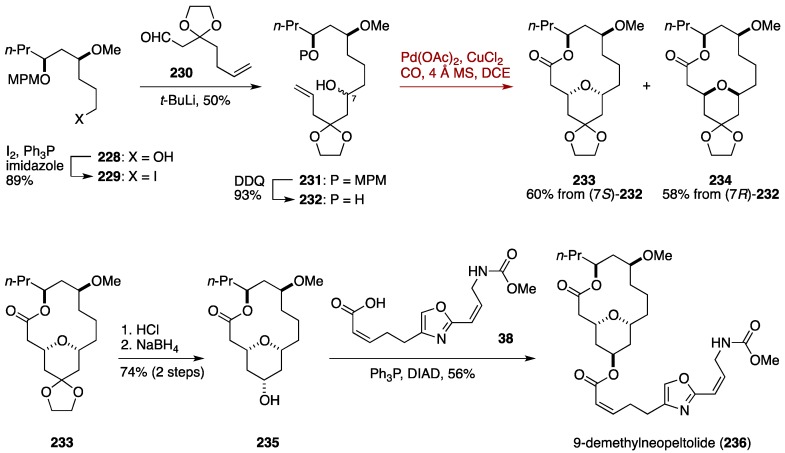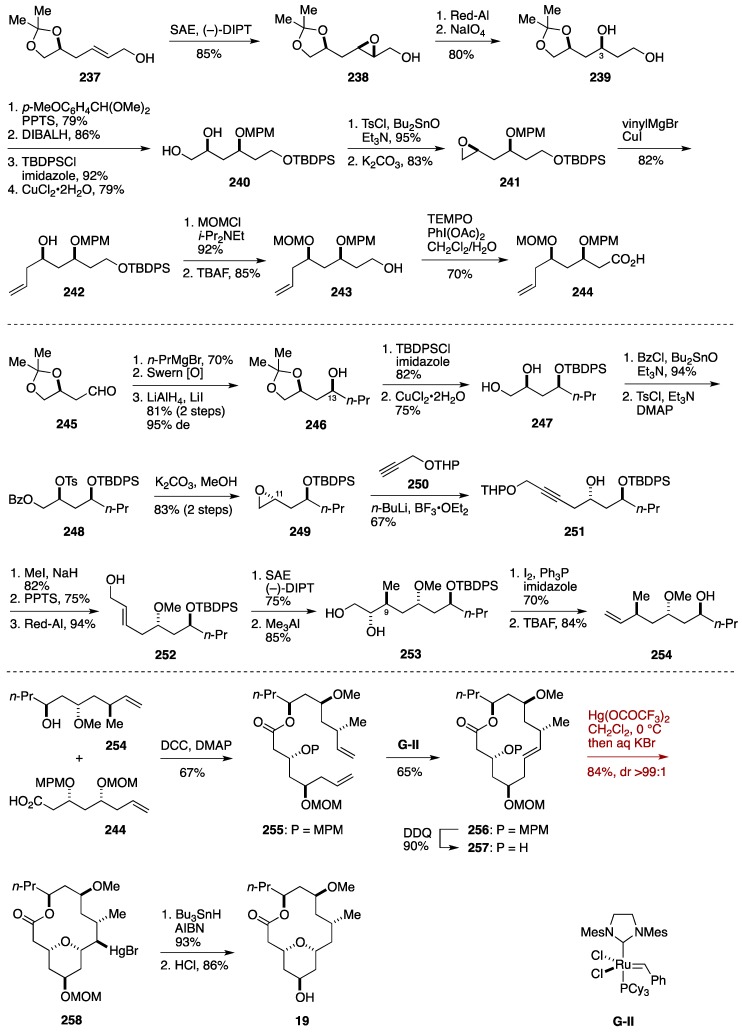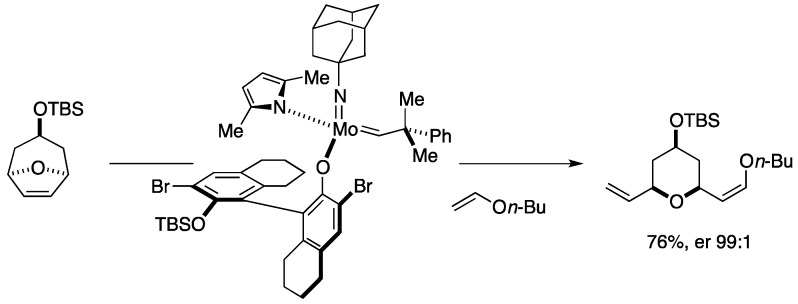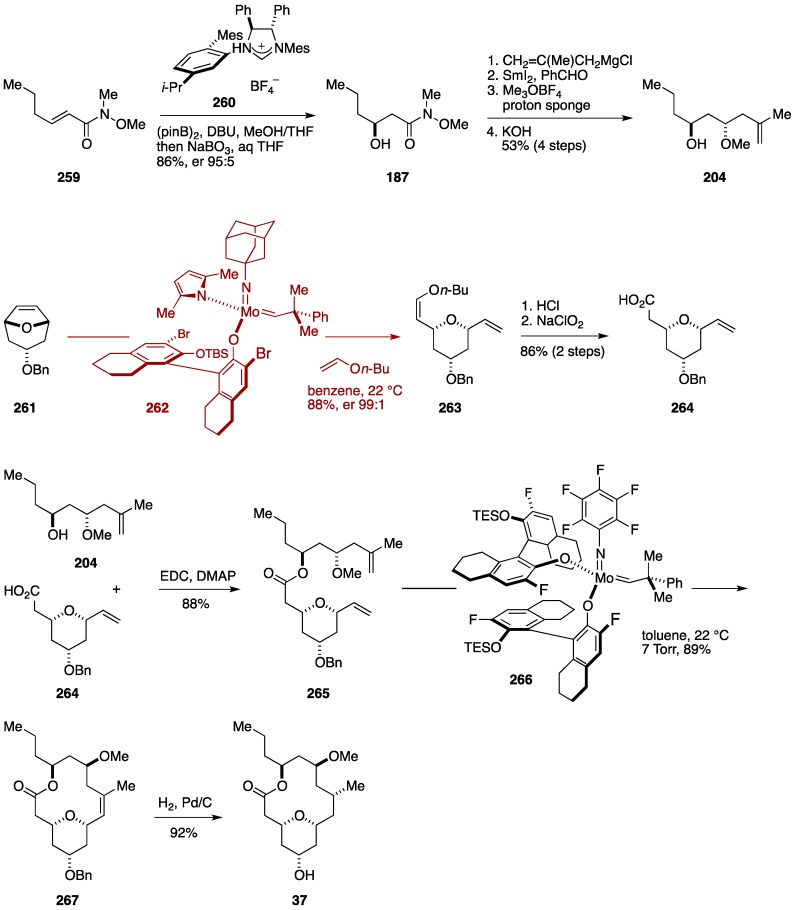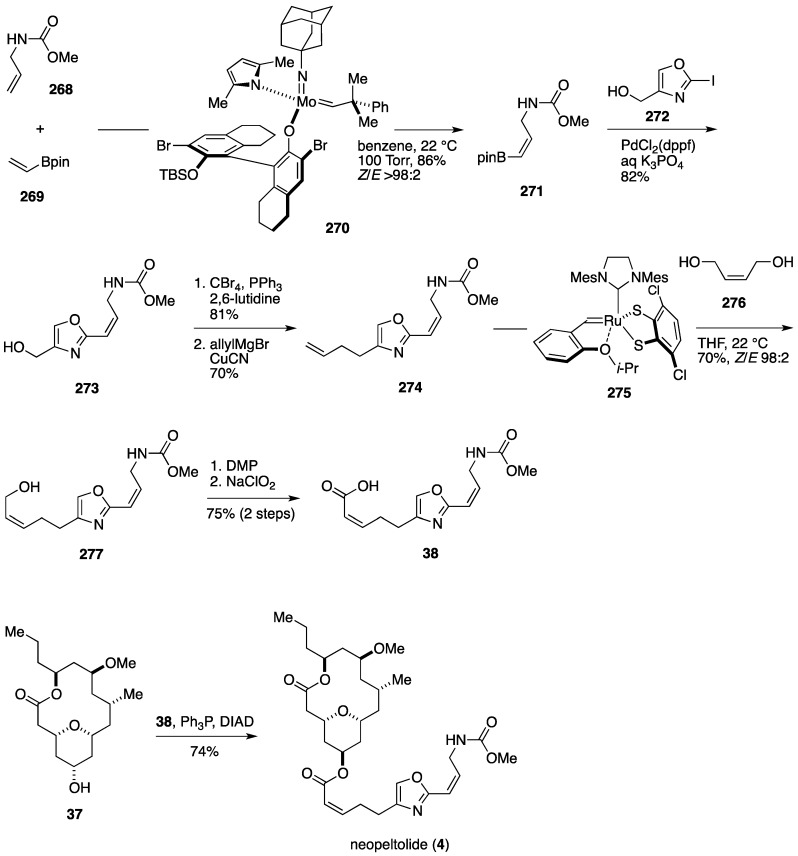Abstract
Tetrahydropyrans are structural motifs that are abundantly present in a range of biologically important marine natural products. As such, significant efforts have been paid to the development of efficient and versatile methods for the synthesis of tetrahydropyran derivatives. Neopeltolide, a potent antiproliferative marine natural product, has been an attractive target compound for synthetic chemists because of its complex structure comprised of a 14-membered macrolactone embedded with a tetrahydropyran ring, and twenty total and formal syntheses of this natural product have been reported so far. This review summarizes the total and formal syntheses of neopeltolide and its analogues, highlighting the synthetic strategies exploited for constructing the tetrahydropyran ring.
Keywords: synthetic methods, tetrahydropyrans, oxocarbenium ions, hetero-Diels-Alder cycloadditions, oxa-Michael reactions, palladium-catalyzed alkoxycarbonylations, oxymercurations, radical cyclizations, ring-closing metathesis
1. Introduction
Marine natural products, mainly the secondary metabolites of marine microorganisms, have been a rich source of structurally diverse and biologically intriguing compounds that are potentially useful for dissecting complex cellular biological events at the molecular level [1,2,3,4,5,6]. Moreover, several marine natural products have recently been developed into clinically approved drugs, including trabectedin and eribulin mesylate, and more are currently under clinical trials [7,8,9]. It is more than likely that marine natural products will continuously have significant impact on chemical biology and drug discovery in the forthcoming decades. However, most marine natural products are not abundantly available from natural sources and marine microorganisms are in many cases difficult to cultivate on a large scale. The scarcity of marine natural products oftentimes precludes their in-depth biological investigations and, currently, total synthesis appears to be the only practical means to overcome the material supply problem at the basic research level. An additional bonus of total synthesis is that it enables manipulation of the biological functions of natural products through structural alterations. Structure-function analyses are important for understanding the mode-of-interactions of natural products with biomolecular targets, given that many natural products are actually multifaceted ligands interacting with multiple biomolecules [10]. Since structurally complex marine natural products are intractable to selective functionalizations, total synthesis lays strong foundation for drug discovery research which in many cases requires structural optimization studies. These beneficial aspects of total synthesis justify its significance in marine natural products chemistry and chemical biology.
Tetrahydropyrans are structural motifs that are abundantly present in a plethora of biologically active marine natural products. Several representative examples are shown in Figure 1. Gambierol (1) was isolated by Satake et al. from cultured cells of the ciguatera causative dinoflagellate Gambierdiscus toxicus and structurally characterized by extensive NMR analyses and a modified Mosher analysis [11,12]. This compound inhibits voltage-gated potassium ion channels (Kv channels) in a subtype-selective manner at nanomolar concentrations [13,14,15,16] and shows potent acute neurotoxicity in mice. Recently, the Botana group reported that the Kv channel inhibitory activity of gambierol resides in the right-half of the molecule and that gambierol and its truncated analogues reduced the levels of extra- and intracellular amyloid β and hyperphosphorylated tau in an in vitro model of Alzheimer’s disease [17,18].
Figure 1.
Structures of gambierol (1), irciniastatin A (2), bryostatin 1 (3), and neopeltolide (4).
Irciniastatin A (2) was isolated by Pettit and co-workers from the marine sponge Ircinia ramosa [19]. Almost simultaneously, Crews et al. reported the isolation of psymberin from the marine sponge Psammocinia sp. [20]. Although the original stereochemical assignments made independently by Pettit and Crews were conflicting, irciniastatin A and psymberin were ultimately shown to be identical through total synthesis by De Brabander and co-workers [21]. Irciniastatin A inhibits protein synthesis and shows a highly potent and selective growth inhibitory effect in human solid tumor cells. A forward genetic screen in Caenorhabditis elegans has shown that iriciniastatin A primarily targets the ribosome [22]. A recent report has shown that irciniastatin A induces a potent and sustained activation of the extracellular signal-regulated kinase (ERK) to promote the ectodomain shedding of tumor necrosis factor (TNF) receptor in the A549 human non-small cell lung adenocarcinoma cell line [23].
Bryostatin 1 (3), a representative marine macrolide natural product that contains tetrahydropyran rings as substructures, was isolated by the Pettit group from the marine bryozoan Bugula neritina and structurally identified by an X-ray crystallographic analysis [24]. More than 20 natural congeners have been identified to date [25]. Bryostatin 1 is a potent and isoform-selective protein kinase C activator and shows anti-cancer, anti-Alzheimer’s disease, and anti-HIV activities. Because of these significant biological activities and synthetically challenging complex molecular architecture, a number of renowned synthetic chemists devoted their efforts to the development of concise synthesis of bryostatin 1 and its congeners [26]. Furthermore, Wender et al. reported function-oriented synthesis [27] of structurally simplified bryostatin analogues (bryologs) and their structure-function relationships [28,29,30].
Neopeltolide (4), a new member of marine macrolide natural products, was identified by Wright and co-workers from a deep-water sponge of the family Neopeltidae, collected off the north coast of Jamaica [31]. The gross structure including the relative configuration was proposed on the basis of extensive 2D-NMR analyses. Later, total syntheses by Panek et al. [32]. and Scheidt et al. [33,34] partially reassigned the relative configuration and established the absolute configuration. The structure of neopeltolide resembles with that of leucascandrolide A, another marine macrolide natural product isolated from a calcareous sponge collected along the east coast of New Caledonia [35]. Wright reported that neopeltolide showed potent antiproliferative activity against several human cancer cell lines at nanomolar concentrations. The Kozmin group has reported that neopeltolide specifically inhibits the complex III of the mitochondrial electron transport chain [36]. Fuwa et al. have recently described the apoptosis-inducing activity of a synthetic analogue of neopeltolide in HL-60 human promyelocytic leukemia cells [37]. However, the mode-of-action of this natural product have not been fully elucidated. The intriguing structure and potent biological activities of neopeltolide have attracted considerable attention from the synthetic community, and twenty total and formal syntheses of this natural product have been reported so far [38,39,40,41,42,43,44,45,46,47,48,49,50,51,52,53,54,55,56,57,58]. Furthermore, several groups have reported the structure-activity relationships of neopeltolide by evaluating the antiproliferative activity of synthetic analogues against cancer cells [34,43,47,56,59,60]. These efforts have culminated in the elucidation of the pharmacophoric structural elements for potent antiproliferative activity [56].
Total synthesis of these complex marine natural products requires efficient and stereoselective construction of tetrahydropyran rings. As such, the synthetic community put significant efforts to the development of methods for the stereoselective synthesis of tetrahydropyran derivatives [61,62]. In the past years, neopeltolide has served as an ideal target compound for synthetic chemists to showcase their creativity in how to construct the tetrahydropyran ring in an efficient and stereoselective manner. This review summarizes the total/formal syntheses of neopeltolide, highlighting the synthetic strategies exploited for constructing the tetrahydropyran ring [63,64].
2. Synthesis of Tetrahydropyrans via Oxocarbenium Ions
As exemplified by the Prins reaction and its variants, reactions that involve an intramolecular addition of an alkene to an oxocarbenium ion intermediate have recently evolved to be powerful and versatile means to construct tetrahydropyran rings in complex settings. Actually, several groups have exploited Prins-type reaction, either intramolecularly or intermolecularly, for the synthesis of the tetrahydropyran ring of neopeltolide.
2.1. Total Synthesis by the Panek Group
Panek and co-workers have developed a versatile method for the synthesis of 2,6-cis- and 2,6-trans-substituted dihydropyran derivatives by means of a formal diastereoselective [4+2]-annulation of chiral allyl or crotyl silanes and aldehydes [65]. As shown in Figure 2, the reaction begins with coupling of the syn-crotylsilane syn-5 with the aldehyde 6 under the influence of a Lewis acid to generate the oxocarbenium ion intermediate 7. Intramolecular addition of the crotylsilane moiety to the oxocarbenium ion with concomitant loss of the silyl group takes place via a boat-like conformer with maximal σ-p orbital overlap, providing the 2,6-cis-substituted dihydropyran derivative 2,6-cis-8. When the anti-crotylsilane anti-5 is used instead, the reaction proceeds via the oxocarbenium ion intermediate 7′ to deliver the 2,6-trans-substituted dihydropyran derivative 2,6-trans-8. Thus, the stereochemical outcome of the [4+2]-annulation reaction depends on the configuration of the crotylsilane used. The versatility of this synthetic method has been demonstrated in total syntheses of apicularen A [66], bistramide A [67], callipeltoside A [68], kendomycin [69], and leucascandrolide A [70].
Figure 2.
Stereoselective synthesis of dihydropyran derivatives via a formal [4+2]-annulation of chiral crotylsilanes and aldehydes.
The Panek group was the first to show that the original assignment of the relative configuration of neopeltolide was incorrect [32]. Inspection of the available spectroscopic data led them to synthesize a selected set of diastereomers to identify the correct structure. Consequently, Panek et al. reassigned the configuration of the C11 and C13 stereogenic centers and at the same time established the absolute configuration as represented by the structure 4.
The Panek synthesis of neopeltolide started with reduction of methyl (R)-(+)-3-methylglutarate (9) with BH3·SMe2 to give an alcohol, which was silylated to deliver the TBDPS ether 10 (Figure 3). Half reduction of the ester moiety and dithioacetalization led to the dithiane 11, which was coupled with the epoxide 12 to afford, after removal of the dithioacetal, β-hydroxy ketone 13. Modified Evans-Tishchenko reduction [71], O-methylation, desilylation, and oxidation [72] provided the aldehyde 14. The tetrahydropyran ring was forged via a diastereoselective formal [4+2]-annulation of the aldehyde 14 and the allylsilane 15, providing the dihydropyran derivative 16 in 75% yield with 10:1 diastereoselectivity. The requisite C5 hydroxy group was introduced after the construction of the macrocyclic skeleton. Displacement of the sulfonyl group with NaCN, reductive removal of the acyl group, reduction of the nitrile group, and oxidation [73] of the resultant aldehyde afforded the seco-acid 17. Yamaguchi macrolactonization [74] of 17 delivered the 14-membered macrolactone 18 in a moderate yield. Oxymercuration of 18 with Hg(OCOCF3)2 resulted in an axial delivery of the reagent and, after reductive workup with NaBH4, the alcohol 19 was isolated in 63% yield with greater than 20:1 diastereoselectivity. Acylation of 19 with bis(2,2,2-trifluoromethyl)phosphonoacetic acid and subsequent Still-Gennari-modified Horner-Wadsworth-Emmons reaction [75] with the aldehyde 20 [76] completed the first total synthesis of neopeltolide (4) (19 linear steps from methyl (R)-(+)-3-methylglutarate).
Figure 3.
Panek synthesis of neopeltolide.
2.2. Total Synthesis by the Scheidt Group
Scheidt and co-workers have shown that coupling of the β-hydroxy dioxinone 21 with the aldehyde 22 in the presence of Sc(OTf)3 gives the oxocarbenium ion intermediate 23, which subsequently undergoes intramolecular Prins cyclization to afford the bicyclic dioxinone 24 (Figure 4). The stereoselectivity of the Prins cyclization is ascribable to a chair-like transition state. Notably, 24 is readily convertible to the 2,6-cis-substituted tetrahydropyran-4-one derivatives 25 simply by heating in DMSO in the presence of H2O [77].
Figure 4.
Stereoselective synthesis of 2,6-cis-substituted tetrahydropyran-4-one derivatives from β-hydroxy dioxinones.
In the Scheidt synthesis of neopeltolide, a Prins-type macrocyclization [78] was successfully implemented to simultaneously construct the tetrahydropyran ring and the macrocyclc skeleton in a single step [33,34]. The synthesis started with Noyori asymmetric hydrogenation [79] of ethyl 3-oxohexanoate (26) to deliver the corresponding β-hydroxy ester (Figure 5). Weinreb amidation [80] and protection of the hydroxy group as its MPM ether gave the amide 27. This was reacted with a lithiation product of the iodide 28 to afford the ketone 29 [81]. Cleavage of the MPM ether, Evans-Tishchenko reduction [82], O-methylation, and methanolysis led to the alcohol 30. The dioxinone 31, prepared in four steps from 3-(t-butyldimethylsilyloxy)propanal via an asymmetric vinylogous Mukaiyama aldol reaction [83], was coupled with the alcohol 30 under Yamaguchi conditions to give the ester 32. Cleavage of the silyl protecting groups and selective oxidation [84] of the liberated primary alcohol delivered the cyclization precursor 33. Treatment of 33 with Sc(OTf)3 afforded the cyclization product 35 in 40% yield, via the oxocarbenium ion 34. Thermolysis of 35 in the presence of H2O provided the ketone 36, which was reduced with NaBH4 to give neopeltolide macrolactone 37. Finally, Mitsunobu reaction [85,86] of 37 with the acid 38 [87] furnished neopeltolide (4). The significance of this work lies in the demonstration of an intramolecular Prins macrocyclization, which effectively realized a 16-linear step synthetic path to neopeltolide. The Scheidt group further applied their Prins macrocyclization strategy to the total synthesis of exiguolide [88].
Figure 5.
Scheidt synthesis of neopeltolide.
2.3. Total Synthesis by the Lee Group
Shortly after the appearance of the Scheidt synthesis of neopeltolide, another macrocyclic Prins cyclization approach toward neopeltolide was reported by the Lee group, as shown in Figure 6 [38]. The Lee synthesis began with asymmetric crotyl transfer reaction [89] of 1-butanal (39) with chiral alcohol 40. The resultant homoallylic alcohol was benzylated and then subjected to ozonolysis to give the aldehyde 41. Chelate-controlled methallylation [90] followed by esterification with 2-diphenylphospinobenzoic acid delivered the ester 42, whose hydroformylation using Rh(CO)2(acac)/P(OPh)3 catalyst [91] led to the aldehyde 43 in 65% yield with 5:1 diastereoselectivity. After masking the aldehyde moiety, the superfluous 2-diphenylphosphinobenzoyl group was removed to liberate the hydroxy group, which was O-methylated to give the methyl ether 44. Hydrogenolysis of the benzyl ether followed by esterification with the carboxylic acid 45, and subsequent exposure to DDQ provided the aldehydic homoallylic alcohol 46. Treatment of 46 with TESOTf/TMSOAc in AcOH at room temperature generated an oxocarbenium ion species 47 that underwent Prins cyclization to afford, after methanolysis of 48, neopeltolide macrolactone 37 in 68% yield. Mitsunobu reaction of 37 with the carboxylic acid 38 furnished neopeltolide (4). The Lee synthesis of neopeltolide was completed in 15 linear steps, harnessing the step-economical aspect of the Prins macrocyclization strategy.
Figure 6.
Lee synthesis of neopeltolide.
2.4. Formal Synthesis by the Maier Group
Maier and co-workers reported the total synthesis of neopeltolide, by exploiting an intermolecular Prins cyclization for the synthesis of the tetrahydropyran ring (Figure 7) [40,43]. The synthesis commenced with Noyori asymmetric hydrogenation of methyl 3-oxobutanoate (49) to give the optically active alcohol 50 with excellent enantioselectivity (98% ee), which was silylated and then reduced to provide the aldehyde 51. Leighton asymmetric allylation [92] of 51 using (R,R)-52 delivered the homoallylic alcohol 53. After O-methylation, the terminal olefin was oxidatively cleaved to give the aldehyde 54, which was treated with Ph3P=CHCOSEt to afford the α,β-unsaturated thioester 55. Diastereoselective conjugate addition of MeMgBr in the presence of CuBr·SMe2 and (S,R)-Josiphos ligand [93] led to the thioester 56, which was reduced under Fukuyama conditions [94] to provide the aldehyde 57. This was reacted with the homoallylic alcohol 58 in the presence of TFA to deliver the tetrahydropyran 59 in 72% yield with 8:1 diastereoselectivity. A three-step protecting group manipulations led to the alcohol 60, which was oxidized [95] and then desilylated to produce the seco-acid 61. Yamaguchi macrolactonization of 61 afforded the macrolactone 62. Cleavage of the MOM group led to neopeltolide macrolatone 37, completing a formal synthesis of neopeltolide (4). This formal synthesis proceeded in 19 linear steps from methyl 3-oxohexanoate (49).
Figure 7.
Maier synthesis of neopeltolide.
2.5. Total Synthesis by the Kozmin Group
Kozmin and co-workers completed the total synthesis of neopeltolide in a racemic form, highlighting a desymmetrizing Prins cyclization for constructing the tetrahydropyran ring [36]. Treatment of the vinylogous ester 63 with TFA in CH2Cl2 at 0 °C resulted in Prins cyclization via the oxocarbenium ion 64 to give, after in situ cleavage of the trifluoroacetyl group of 65, the tetrahydropyran derivative 66 in 84% yield (Figure 8). Benzylation of the hydroxy group followed by Wacker oxidation of the olefin provided the methyl ketone 67. Treatment of 67 with Cy2BCl/Et3N generated a boron enolate, which was reacted with the aldehyde 68 to deliver the alcohol 69 in 81% yield with excellent stereocontrol (dr > 98:2) [96]. Wittig methylenation of 69 and acidic workup gave the ketone 70, which was stereoselectively reduced with Et2BOMe/NaBH4 [97] to afford the 1,3-diol 71. After hydrolysis of the methyl ester moiety [98], Yamaguchi macrolactonization of the resultant seco-acid led to the macrolactone 72. Hydrogenation of the exo-methylene of 72 gave the alcohol 73. Mitsunobu inversion of 73 (p-NO2C6H4CO2H, Ph3P, DEAD) and methanolysis of the resultant p-nitrobenzoate delivered the alcohol 74. O-Methylation of 74 was followed by hydrogenolysis of the benzyl ether to afford the neopeltolide macrolactone 37. Mitsunobu coupling of 37 with the carboxylic acid 38 provided neopeltolide (4). A concise synthesis of neopeltolide in a racemic form was thus achieved in 15 linear steps from a commercially available material.
Figure 8.
Kozmin synthesis of neopeltolide.
2.6. Formal Synthesis by the Floreancig Group
Floreancig et al. have devised a DDQ-mediated oxocarbenium ion generation/intramolecular Prins cyclization for concise synthesis of 2,6-cis-substituted tetrahydropyran-4-one derivatives (Figure 9) [99]. The synthetic strategy requires appropriate elaboration of cyclization precursors; upon oxidation of an allylic or benzylic ether moiety of 75 with DDQ, the corresponding oxocarbenium ion 76 is generated, to which an enol acetate moiety attacks intramolecularly with loss of the acetyl group to provide the 2,6-cis-substituted tetrahydropyran-4-one derivative 77. The stereoselectivity can be reasoned by considering a chair-like transition state, as shown. The present synthetic strategy has been applied to the total synthesis of clavosolide A [100].
Figure 9.
DDQ-mediated intramolecular Prins cyclization.
The Floreancig group has successfully applied their DDQ-mediated intramolecular Prins cyclization strategy to neopeltolide synthesis (Figure 10) [44]. The synthesis began with etherification of optically active alcohol 78, prepared in one step from a commercially available material, with the trichloroacetimidate derivative 79 under the influence of TfOH to give the vinyl iodide 80, which was coupled with the alkyne 81 under Sonogashira conditions [101,102] to provide the endiyne 82. Intramolecular hydrosilylation of 82 catalyzed by Pt(DVDS) followed by oxidation of the derived vinyl silane afforded the hydroxy ketone 83 in 57% yield in a regioselective manner [103]. Evnas-Tishchenko reduction and O-methylation led to the methyl ether 84. Hydrolysis of the ester moieties of 84 gave a seco-acid, which underwent Yamaguchi macrolactonization to deliver the macrolactone 85. Addition of AcOH to the terminal alkyne was catalyzed by [Ru(p-cymene)Cl2]2 to afford the enol acetate 86 (82% yield, 5:1 regioselectivity) [104]. Exposure of 86 to DDQ in the presence of 2,6-dichloropyridine and LiClO4 in 1,2-dichloroethane induced the expected oxocarbenium ion generation/intramolecular Prins cyclization sequence to provide the ketone 87 in 58% yield. Stereoselective hydrogenation of 87 furnished known compound 36, which intercepts the Scheidt synthesis of neopeltolide. The Floreancig formal synthesis was completed in 13 linear steps from 2-butyn-1-ol.
Figure 10.
Floreancig total synthesis of neopeltolide.
2.7. Formal Synthesis by the Yadav Group
Yadav and Kumar described a formal synthesis of neoleptolide based on Lee’s intramolecular Prins macrocyclization strategy (Figure 11) [48]. The Yadav synthesis started with conversion of (S)-citronellol (88) into the aldehyde 89, whose intermolecular Prins cyclization with the homoallylic alcohol 90 gave the tetrahydropyran derivative 91 (56% yield), where the C11 and C13 stereogenic centers were established. A three-step functional group manipulation led to the iodide 92. The terahydropyran ring of 92 was cleaved by treatment with zinc to deliver the alcohol 93, which was elaborated to the alcohol 94 in four steps. The remainder of the synthesis was achieved in the same way as that reported by Lee et al. [38].
Figure 11.
Yadav formal synthesis of neopeltolide.
2.8. Formal Synthesis by the Jennings Group
Martinez-Solorio and Jennings reported a formal synthesis of (−)-neopeltolide, the enantiomer of the natural product, by using an oxocarbenium ion formation/stereoselective reduction of a six-membered hemiacetal derivative (Figure 12) [51]. Stereoselective tetrahydropyran synthesis by means of reduction of six-membered hemiacetals with Et3SiH in the presence of a Lewis acid was originally developed by Kishi et al. [105]. The synthesis commenced with Brown asymmetric allylation [106] of 1-butanal (39) to give a homoallylic alcohol, which was benzylated and then ozonolyzed to deliver the aldehyde 41. Chelate-controlled methallylation of 41, acylation with acryloyl chloride, and ring-closing metathesis using the second-generation Grubbs catalyst (G-II) [107] provided the α,β-unsaturated lactone 95. Stereoselective hydrogenation/hydrogenolysis and silylation gave the lactone 96, which was reacted with an aluminum amide prepared from MeONHMe·HCl/AlMe3 to produce the amide 97. O-Methylation, DIBALH reduction, and Brown asymmetric allylation led to the homoallylic alcohol 98. Olefin cross-metathesis [108] of 98 with methyl acrylate under the influence of G-II delivered the α,β-unsaturated ester 99, which was treated with PhCHO and KOt-Bu to afford the benzylidene acetal 100 via intramolecular oxa-Michael reaction [109]. Hydrogenolysis of 100 followed by acid treatment provided the β-hydroxy lactone 101, which was protected and then allylated to give the hemiacetal 102. Upon treatment of 102 with Et3SiH and TFA, the oxocarbenium ion 103 was generated and stereoselectively reduced to furnish the tetrahydropyran derivative 104 in 72% yield with 20:1 diastereoselectivity. Ozonolysis, Pinnick oxidation, and desilylation led to the seco-acid ent-61. Yamaguchi macrolactonization of ent-61 provided the macrolactone ent-62, from which the MOM group was removed to afford neopeltolide macrolactone ent-37. The present formal synthesis proceeded in 24 linear steps from 1-butanal (39).
Figure 12.
Jennings formal synthesis of neopeltolide.
3. Synthesis of Tetrahydropyrans via Hetero-Diels-Alder Cycloaddition
Hetero-Diels-Alder cycloaddition of Danishefsky’s dienes and aldehydes under Lewis acid catalysis is an efficient means to access a variety of 2,6-disubstituted tetrahydropyran-4-one derivatives [110]. The synthetic utility of hetero-Diels-Alder cycloaddtion has been greatly improved by the development of Jacobsen’s chiral chromium(III) catalysts [111]. This section illustrates three independent total/formal syntheses of neopeltolide, each featuring a hetero-Diels-Alder cycloaddition for constructing the tetrahydropyran substructure.
3.1. Total Synthesis by the Paterson Group
Paterson and Miller implemented a hetero-Diels-Alder cycloaddition in a late stage of their neopeltolide synthesis (Figure 13) [41]. The Paterson synthesis began with Noyori asymmetric hydrogenation of ethyl 3-oxohexanoate (26) to give an optically active β-hydroxy ester, which was silylated and then reduced to deliver the aldehyde 105. Asymmetric methallylation of 105 was followed by O-methylation to afford the methyl ether 106, which was ozonolyzed and then homologated to provide the α,β-unsaturated ester 107. After oxidation state adjustment, the resultant aldehyde 108 was reduced using the imidazolidinone catalyst 109 and Hantzch ester 110 [112] to give the aldehyde 111 in 80% yield with moderate diastereoselectivity (dr 76:24). Exposure of a mixture of 111 and the 2-silyloxydiene 112 to the Jacobsen’s chiral tridentate chromium(III) catalyst 113 furnished, after mild acidic workup, the 2,6-cis-substituted tetrahydropyran-4-one 114 in 78% yield. At this stage, the major diastereomer 114 could be separated from its C9 epimer. Cleavage of the MPM ether, a two-stage oxidation, and desilylation gave the seco-acid 115. Yamaguchi macrolactonization of 115 provided the macrolactone 36, which was reduced with NaBH4 and then coupled with the carboxylic acid 38 to furnish neopeltolide (4). The present synthesis was completed in 18 linear steps from ethyl 3-oxohexanoate (26).
Figure 13.
Paterson total synthesis of neopeltolide.
3.2. Formal Synthesis by the Raghavan Group
In contrast to the Paterson group, Raghavan and Samanta exploited a hetero-Diels-Alder cycloaddition at an early stage of their neopeltolide synthesis (Figure 14) [54]. The Raghavan synthesis started with organocatalytic 1,4-reduction of the α,β-unsaturated aldehyde 117, prepared in three steps from 2-chloroacetone (116), with the imidazolidinone catalyst 118 and Hantzch ester 110 to deliver the aldehyde 119 in 75% yield with excellent enantioselectivity (95% ee). Then, hetero-Diels-Alder cycloaddition with Danishefsky’s diene 120 [113] was undertaken in the presence of (S,S)-Cr(III)-salen complex 121 [114] to afford, after acidic workup, the dihydropyranone 122 in 75% yield as the only detectable isomer. Luche reduction [115] of 122 followed by acetylation gave the acetate 123, whose Ireland-Claisen rearrangement [116,117] provided the ester 124, after esterification with diazomethane. Reduction of 124 with LiAlH4 and subsequent silylation delivered the sulfide 125. Lithiation of 125 with LiDBB [118] followed by addition of the aldehyde 105 produced the coupling product 126 in 60% yield as a mixture of diastereomers. This mixture was oxidized and then desilylated to give the β-hydroxy ketone 127, which was reduced using the modified Evans-Tishchenko protocol to afford, after O-methylation, the diester 128. Solvolysis of the esters, selective oxidation, and Yamaguchi macrolactonization led to the macrolactone 18. Finally, oxymercuration of 18 according to Panek and co-workers [32] delivered neopeltolide macrolactone 19. The present formal synthesis was achieved in 21 linear steps from 2-chloroacetone.
Figure 14.
Raghavan formal synthesis of neopeltolide.
3.3. Total Synthesis by the Arun K. Ghosh Group
Arun K. Ghosh and co-workers from Purdue University utilized a hetero-Diels-Alder cycloaddition for forging the tetrahydropyran ring at a late stage of their neopeltolide synthesis (Figure 15) [57]. The Arun K. Ghosh synthesis commenced with desymmetrization of 3-methylglutaric anhydride (129) with lipase PS-30 to give a carboxylic acid, which was selectively reduced with BH3·SMe2 to deliver the alcohol 130. Oxidation of 130 followed by acetalization led to the acetal 131. Next, the C11 and C13 stereogenic centers were introduced by a two-fold use of Brown asymmetric allylation. Thus, LiAlH4 reduction, oxidation, and asymmetric allylation gave the homoallylic alcohol 132. O-Methylation, Lemieux-Johnson oxidation, and the second asymmetric allylation provided the homoallylic alcohol 133. Deprotection of the acetal of 133 was followed by Horner-Wadsworth-Emmons reaction [119] to deliver the α,β-unsaturated ketone 134, which was treated with TESOTf/Et3N to afford the enol silyl ether 135 with concomitant protection of the free hydroxy group. Hetero-Diels-Alder cycloaddition of 135 with 2-tosyloxyacetaldehyde by the action of Jacobsen’s chiral chromium(III) catalyst ent-113 provided the 2,6-cis-substituted tetrahydropyran-4-one 136 in 83% yield with excellent diastereoselectivity (dr 97:3), after acidic workup. Here, the choice of the aldehyde component was critical for the success of the hetero-Diels-Alder cycloaddition. When a one carbon-homologated aldehyde, such as 3-benzyloxypropanal or 3-t-butyldimethylsilyloxypropanal, were reacted with the diene 135, the corresponding cycloaddition product was isolated in only moderate yield. The keto group of 136 was temporarily masked and then the tosyl group was displaced with NaCN to give the cyanide 137. Hydrolysis of the nitrile group followed by deprotection of the acetal led to the seco-acid 138, which underwent Yamaguchi macrolactonization to afford the macrolactone 139. Hydrogenation and NaBH4 reduction delivered neopeltolide macrolatone 37, which was esterified with the carboxylic acid 38 under Mitsunobu conditions to furnish neopeltolide (4). The Arun K. Ghosh synthesis was finished in 22 linear steps from 3-methylglutaric anhydride (129).
Figure 15.
Arun K. Ghosh total synthesis of neopeltolide.
4. Synthesis of Tetrahydropyrans via Ring-Closing Metathesis
Olefin metathesis has evolved as an indispensable means for connecting C–C bonds in complex settings because of its remarkable functional group tolerance as well as the commercial availability of various catalysts with a range of reactivity [120,121]. Now, olefin metathesis is an established method for constructing small- to large-membered cyclic alkenes [122,123].
Total Synthesis by the Fuwa Group (First-Generation Synthesis)
Fuwa and co-workers have developed an efficient method for dihydropyran synthesis, in which a Suzuki-Miyaura coupling [124,125,126] and a ring-closing metathesis were exploited as key C–C bond forming reactions [127]. An example is illustrated in Figure 16. Suzuki-Miyaura coupling of the alkylborane 141, prepared from the olefin 140, and the enol phosphate 142 under the influence of a base and a Pd catalyst provided the enol ether 143, which participated in ring-closing metathesis by the action of G-II catalyst to afford the dihydropyran 144. Notably, the product 144 can be readily transformed to synthetically useful derivatives, including tetrahydropyrans and spiroacetals. The present synthetic methodology has been applied to total syntheses of attenol A [127] and gambieric acid A [128,129] and a partial synthesis of okadaic acid [130].
Figure 16.
Suzuki-Miyaura coupling/ring-closing metathesis sequence.
The Fuwa synthesis started with Keck asymmetric allylation [131] of the aldehyde 145 to give a homoallylic alcohol (93%, >95% ee), which was protected as its MPM ether and then homologated via olefin cross-metathesis to deliver the α,β-unsaturated ester 146 (Figure 17) [39]. DIBALH reduction of 146 provided an allylic alcohol, whose Sharpless asymmetric epoxidation using (−)-DET as a chiral ligand afforded the epoxy alcohol 147 as a single stereoisomer. Iodination and zinc reduction gave the allylic alcohol 148, setting the C5 stereogenic center. A three-step protecting group manipulation led to the acetate 149, which was enolized with KHMDS in the presence of (PhO)2P(O)Cl to provide the enol phosphate 150.
Figure 17.
Fuwa total synthesis of neopeltolide.
Meanwhile, the iodide 155, the coupling partner of the enol phosphate 150, was synthesized from known aldehyde 151. The C11 and C13 stereogenic centers were established through a two-fold application of Brown asymmetric allylation. Thus, asymmetric allylation of 151 with (+)-Ipc2Ballyl gave the homoallylic alcohol 152, which was O-methylated and then ozonolyzed to deliver the aldehyde 153. The second asymmetric allylation using (−)-Ipc2Ballyl afforded the homoallylic alcohol 154. After hydrogenation, the free hydroxy group was masked as its MPM ether [132]. Subsequent desilylation and iodination furnished the iodide 155.
The Suzuki-Miyaura coupling of the alkylborane 156, generated from the iodide 155 by lithiation and trapping with B-MeO-9-BBN [133], with the enol phosphate 150 was achieved by the action of Pd(PPh3)4 and Cs2CO3. The resultant enol ether 157 was subjected to ring-closing metathesis using G-II catalyst, giving rise to the dihydropyran 158 in 78% yield (two steps). Stereoselective hydrogenation of 158 led to the tetrahydropyran derivative 159 in 81% yield as a single stereoisomer. Desilylation, oxidation [134], and esterification gave the ester 160. Removal of the MPM group and ester hydrolysis provided a seco-acid, which cleanly underwent Yamaguchi macrolactonization to afford neopeltolide macrolatone 37 after cleaving the BOM ether. Finally, 37 was coupled with the carboxylic acid 38 under Mitsunobu conditions furnished neopeltolide (4). The present synthesis proceeded in 24 linear steps from 1,3-propanediol.
5. Synthesis of Tetrahydropyrans via Intramolecular Radical Cyclizations
Because of their excellent functional group compatibility and powerful bond-forming ability, radical cyclizations have been exploited in the synthesis of small- and medium-sized ring systems, especially five- and six-membered carbo- and heterocycles [135]. Lee and co-workers have reported that intramolecular radical cyclization of β-alkoxyacrylates is a highly useful method for the stereoselective synthesis of 2,5-cis-substituted tetrahydrofurans and 2,6-cis-substituted tetrahydropyrans [136].
Formal Synthesis by the Taylor Group
Taylor and co-workers took advantage of an ether transfer reaction developed in their laboratory [137] and Lee’s radical cyclization methodology for constructing the tetrahydropyran ring of neopeltolide (Figure 18) [42]. The Taylor synthesis began with reduction of methyl (R)-(+)-3-methylglutarate (9) with BH3·SMe2, which was followed by Weinreb amidation and Dess-Martin oxidation to give the aldehyde 160. Asymmetric allylation of 160 using Soderquist’s reagent 161 [138] delivered the homoallylic alcohol 162. After protection as its BOM ether, the resultant product was reacted with the alkyllithium 163 prepared from the corresponding α-hydroxy sulfide to afford the ketone 164. Evans-Tishchenko reduction followed by O-methylation afforded the methyl ether 165. Treatment of 165 with ICl resulted in ether transfer reaction to provide the iodide 166 in 71% yield with greater than 20:1 diastereoselectivity. 1,4-Addition of 166 to ethyl propiolate led to the acrylate 167, whose radical cyclization using n-Bu3SnH/AIBN in refluxing toluene furnished the tetrahydropyran derivative 168 in 95% yield with 19:1 diastereoselectivity. Thus, the tetrahydropyran ring of neopeltolide was constructed in a highly stereocontrolled manner, by combining an ether transfer reaction and a radical cyclization. Ester hydrolysis, Yamaguchi macrolactonization, and debenzylation afforded neopeltolide macrolactone 37. The Taylor synthesis was completed in a 14-linear step sequence from methyl (R)-(+)-3-methylglutarate (9).
Figure 18.
Taylor formal synthesis of neopeltolide.
6. Synthesis of Tetrahydropyrans via Intramolecular Oxa-Michael Reaction
Despite of their moderate nucleophilicity, intramolecular 1,4-addition of alcohols to α,β-unsaturated carbonyl systems (oxa-Michael addition) is known as a useful method for the synthesis of tetrahydropyran derivatives [139,140]. The stereochemical outcome of intramolecular oxa-Michael reaction depends on the local structure and reactivity of substrates and the reaction conditions employed. In general, intramolecular oxa-Michael reaction of ζ-hydroxy α,β-unsaturated esters catalyzed by a base produces 2,6-trans-substituted tetrahydropyrans under kinetic conditions, whereas it provides 2,6-cis-substituted tetrahydropyrans under thermodynamic conditions [141]. Intramolecular oxa-Michael reaction can also be catalyzed by an acid, provided the conjugate acceptor sufficiently electrophilic [141]. Notably, 2-tetrahydropyranylacetic acid substructures found in many tetrahydropyran-containing natural products might be biosynthetically derived from the corresponding ζ-hydroxy α,β-unsaturated thioesters via intramolecular oxa-Michael reaction [142,143,144].
6.1. Formal Synthesis by the Hong Group
Hong and co-workers developed an allylic oxidation/intramolecular oxa-Michael addition cascade for the stereoselective synthesis of 2,6-cis-substituted tetrahydropyran derivatives [45]. Hong et al. focused on the Thorpe-Ingold effect of a dithioacetal group for promoting intramolecular oxa-Michael reaction. An example is shown in Figure 19. Thus, allylic oxidation of the alcohol 169 provided the α,β-unsaturated aldehyde 170, which readily underwent intramolecular oxa-Michael reaction to deliver the 2,6-cis-substituted tetrahydropyran 171. The stereoselectivity of this cascade reaction can be explained by the conformation of 170, where the conjugate acceptor is pseudo-equatorially exposed to avoid unfavorable non-bonding interaction with the dithioacetal.
Figure 19.
Allylic oxidation/intramolecular oxa-Michael addition cascade.
The Hong synthesis commenced with alkylation of 1,3-dithiane (172) with (R)-5-iodo-4-methylpentene (173) [145], prepared in three steps from a commercially available material, to give the dithiane derivative 174, which was further alkylated with (R)-epichlorohydrin (175) to deliver the epoxide 176 (Figure 20) [45]. Addition of EtMgBr in the presence of CuI provided the alcohol 177, from which the dithioacetal was removed to give the β-hydroxy ketone 178. Evans-Tishchenko reduction followed by O-methylation led to the methyl ether 179, which was dihydroxylated with AD-mix β [146] and then treated with p-tosylimidazole/NaH [147] to afford the epoxide 180. The epoxide 180 was coupled with a lithiated derivative of the dithiane 181 to deliver the triol 182. Exposure of 182 to MnO2 promoted allylic oxidation/intramolecular oxa-Michael addition cascade to furnish the aldehyde 183, which was in situ transformed to the corresponding ester 185 by the action of dimethyltriazolium iodide (184), DBU, and MeOH [148]. Hydrolysis of 185 was followed by macrolactonization under Shiina conditions [149] provided the macrolactone 186. Removal of the dithioacetal and reduction of the resultant ketone afforded neopeltolide macrolactone 37. The longest linear sequence of the Hong formal synthesis was 17 steps from a commercially available material.
Figure 20.
Hong formal synthesis of neopeltolide.
6.2. Total Synthesis by the Roulland Group
The Roulland group implemented a ruthenium-catalyzed ene-yne coupling/intramolecular oxa-Michael addition cascade in constructing the tetrahydropyran ring of neopeltolide (Figure 21) [46]. This type of cascade reaction was originally developed by Trost and co-workers [150]. The Roulland synthesis began with asymmetric hydrogenation [151] of ethyl 3-oxohexanoate (26) to give a β-hydroxy ester, which was converted to the amide 187. Addition of 2-methallylmagnesium chloride to 187 was followed by Evans-Tishchenko reduction to provide the alcohol 188. After acylation with acryloyl chloride, ring-closing metathesis of the resultant ester delivered the α,β-unsaturated lactone 189. Stereoselective hydrogenation and acid-catalyzed solvolysis gave the ester 190, which was O-methylated and then reduced with DIBALH to afford the aldehyde 191. InBr3-catalyzed asymmetric propargylation of 191 using the chiral allenyl alcohol 192 furnished the alcohol 193 [152]. After desilylation, the resultant terminal alkyne was reacted with 4,4-diethoxybut-1-ene (194) in the presence of [Cp*Ru(CH3CN)3]PF6 and acetic acid to promote alkyne-enal coupling/intramolecular oxa-Michael addition cascade, giving rise to the 2,6-cis-substituted tetrahydropyran derivative 195, after in situ hydrolysis of the diethyl acetal moiety. Addition of a catalytic amount of acetic acid was instrumental in achieving the cascade reaction in an efficient manner. Oxidative cleavage of the exo-methylene, Pinnick oxidation, and Yamaguchi macrolactonization afforded the macrolactone 36. Finally, NaBH4 reduction followed by Mitsunobu reaction with the carboxylic acid 38 furnished neopeltolide (4). The Roulland synthesis proceeded in 17 linear steps from ethyl 3-oxohexanoate (26).
Figure 21.
Roulland total synthesis of neopeltolide.
6.3. Total Synthesis by the Fuwa Group (Second-Generation Synthesis)
The Fuwa group disclosed a second-generation synthesis of neopeltolide, featuring an intramolecular oxa-Michael addition of a ζ-hydroxy α,β-unsaturated ester under thermodynamic conditions to forge the tetrahydropyran ring, and a macrocyclic ring-closing metathesis for constructing the 14-membered skeleton (Figure 22) [49,56]. The synthesis started with Nagao asymmetric acetate aldol reaction [153] of trans-cinnamaldehyde (196) with a titanium enolate of the chiral thiazolidinethione 197 to deliver the alcohol 198 in 87% yield (dr 11:1). After removal of the chiral auxiliary via amidation, addition of allylmagnesium chloride gave the ketone 199, which was reduced with Evans-Tishchenko protocol to afford the β-hydroxy ketone 200. Olefin cross-metathesis reaction of 200 with methyl acrylate proceeded selectively at the terminal olefin, giving rise to the α,β-unsaturated ester 201, after BOM etherification. The crucial intramolecular oxa-Michael reaction was undertaken by methanolysis of the propionate group followed by DBU treatment in toluene at 100 °C to provide the 2,6-cis-substituted tetrahydropyran 202 in 53% yield (two steps). Hydrolysis of the ester moiety then afforded the carboxylic acid 203. The coupling partner of 203, the alcohol 204, was prepared from (R)-epichlorohydrin in seven steps. Yamaguchi esterification of 203 with 204 provided the ester 205, which underwent ring-closing metathesis under the influence of G-II and 1,4-benzoquinone [154] in toluene at 100 °C to furnish the macrocycle 206 in 85% yield. Hydrogenation/hydrogenolysis of 206 followed by Mitsunobu esterification of the derived alcohol 37 with the carboxylic acid 38 completed the total synthesis of neopeltolide (4). The present synthesis proceeded in a 13 linear-step sequence from trans-cinnamaldehyde (196).
Figure 22.
Fuwa total synthesis of neopeltolide.
6.4. Formal Synthesis by the Subhash Ghosh Group
Subhash Ghosh and co-workers from Indian Institute of Chemical Technology reported a formal synthesis of neopeltolide, featuring a palladium-catalyzed intramolecular oxa-Michael addition for constructing the tetrahydropyran substructure [55]. Another feature of the Subhash Ghosh synthesis is the use of Jacobsen hydrolytic kinetic resolution methodology [155] for controlling the C11 and C13 stereogenic centers. The synthesis commenced with known alcohol 207, prepared in two steps via an Evans asymmetric alkylation (Figure 23). After silylation, mCPBA epoxidation of the terminal olefin gave an epoxide as a mixture of diastereomers, whose hydrolytic kinetic resolution provided the epoxide 209 with >98% de. Addition of vinylmagnesium bromide in the presence of CuI and methylation of the resultant alcohol delivered the methyl ether 210. mCPBA epoxidation of 210 was followed by hydrolytic kinetic resolution to afford the epoxide 211 with >98% de. Addition of EtMgBr/CuI gave the alcohol 212, which was benzylated and then desilylated to produce the alcohol 213. Tosylation, displacement with cyanide, and DIBALH reduction provided the aldehyde 214. Horner-Wadsworth-Emmons reaction of 214 with the phosphonate 215 under Masamune-Roush conditions gave rise to the α,β-unsaturated ketone 216. After removal of the silyl group, intramolecular oxa-Michael reaction was best performed by using Pd(CH3CN)4BF4 catalyst in CH2Cl2 at room temperature [156], affording the 2,6-cis-substituted tetrahydropyran-4-one 218 in 60% yield with 4:1 diastereoselectivity. After separation of the diastereomers, hydrogenolysis of the benzyl ethers, selective oxidation of the primary alcohol to the corresponding carboxylic acid, and Yamaguchi macrolactonization furnished the ketone 36, thereby intersecting the Scheidt synthesis. The Subhash Ghosh formal synthesis was completed in 22 steps from a commercially available material.
Figure 23.
Subhash Ghosh formal synthesis of neopeltolide.
Florence and Cadou reported their synthetic studies on neopeltolide, in which a transannular oxa-Michael reaction was planned as a key transformation [157]. Very recently, Boddy et al. reported the synthesis of a neopeltolide model compound by using a transannular oxa-Michael addition [158].
7. Synthesis of Tetrahydropyrans via Palladium-Catalyzed Intramolecular Alkoxycarbonylation
Semmelhack et al. developed palladium-catalyzed intramolecular alkoxycarbonylation of alkenol derivatives, allowing access to a range of tetrahydropyran derivatives under mild conditions [159]. An example is given in Figure 24. The stereochemical consequence generally depends on the local structure of substrates and can be reasoned by the conformation of the intermediary palladium-complexed species [160].
Figure 24.
Palladium-catalyzed intramolecular alkoxycarbonylation.
7.1. Formal Synthesis by the She Group
She et al. utilized a desymmetrizing palladium-catalyzed intramolecular alkoxycarbonylation for constructing the tetrahydropyran ring of neopeltolide (Figure 25) [52]. The synthesis began with Krische iridium-catalyzed double asymmetric carbonyl allylation [161,162] of 1,3-propanediol (222) to deliver the bis-homoallylic alcohol 223 in 70% yield. Desymmetrizing palladium-catalyzed intramolecular alkoxycarbonylation of 223 in the presence of PdCl2/CuCl2 in CH3CN/MeOH under CO atmosphere at room temperature afforded the 2,6-cis-substituted tetrahydropyran derivative 224 in 83% yield. Benzylation of 224 under acidic conditions was followed by the double bond transposition [163], and ensuing ester hydrolysis gave the carboxylic acid 225. The macrocyclic skeleton was forged according to the second-generation Fuwa synthesis. Thus, Shiina esterification of 225 with the alcohol 204 provided the ester 226, whose ring-closing metathesis using the second-generation Hoveyda-Grubbs catalyst (HG-II) [164] afforded the macrocycle 227. Finally, hydrogenation/hydrogenolysis funished neopeltolide macrolactone 37. The She formal synthesis was consisted of 12 linear steps from l-valinol via the alcohol 204.
Figure 25.
She formal synthesis of neopeltolide.
7.2. Total Synthesis of 9-Demethylneopeltolide by the Dai Group
9-Demethylneopeltolide is a synthetic analogue of neopeltolide, originally reported by the Fuwa group [47]. This analogue showed potent antiproliferative activity against the P388 murine leukemia cell line. Dai and co-workers reported a total synthesis of 9-demethylneopeltolide, which involved an innovative use of palladium-catalyzed intramolecular alkoxycarbonylation for simultaneous construction of the tetrahydropyran ring and the macrocyclic skeleton [165]. Thus, Dai et al. envisioned that treatment of appropriately designed alkenediols, such as that shown in Figure 26, with Pd(OAc)2/CuCl2/CO undergoes an oxypalladation (step 1) to deliver the intermediary organopalladium species, which further participates in a macrocyclic alkoxycarbonylation (step 2) to afford tetrahydropyran-embedded macrocycles.
Figure 26.
Palladium-catalyzed macrocyclic alkoxycarbonylation.
The Dai synthesis of 9-demethylneopeltolide (236) started with iodination of known alcohol 228, prepared in eight steps from ethyl 3-oxohexanoate, to give the iodide 229 (Figure 27). The iodide 229 was lithiated with t-BuLi and coupled with the aldehyde 230 to afford the adduct 231, from which the MPM group was removed to provide the alcohol 232 as a 1:1 mixture of diastereomers. Macrocyclic palladium-catalyzed alkoxycarbonylation of 232 was achieved in the presence of Pd(OAc)2/CuCl2 and 4 Å molecular sieves in 1,2-dichloroethane at room temperature under CO atmosphere, giving a separable mixture of the macrocycles 233 and 234. Hydrolysis of the acetal of 233 and subsequent NaBH4 reduction provided the alcohol 235, which was coupled with the carboxylic acid 38 to afford 9-demethylneopeltolide (236).
Figure 27.
Dai total synthesis of 9-demethylneopeltolide.
8. Synthesis of Tetrahydropyrans via Transannular Oxymercuration
Oxymercuration is a classical method for hydration of alkenes and alkynes to give alcohols and ketones, respectively. This method can be applied to the synthesis of ethers by using an alcohol instead of H2O. Thus, oxymercuration of δ-alkenyl alcohols provides tetrahydropyran derivatives, after demercuration; addition of Hg(OAc)2 or its equivalent to an alkene forms an mercurinium ion intermediate, to which an anti-specific addition of an alcohol takes place to give an ether. Therefore, the stereochemical outcome depends on the diastereoselectivity of the mercurinium ion forming step.
Formal Synthesis by the Sharma Group
The Sharma group synthesized two key fragments from L-malic acid and then forged the macrocyclic skeleton of neopeltolide by means of an esterification, a ring-closing metathesis, and a transannular oxymercuration (Figure 28) [53].
Figure 28.
Sharma formal synthesis of neopeltolide.
The synthesis of one of the key fragments, the carboxylic acid 244, started with Sharpless asymmetric epoxidation of the allylic alcohol 237 [166] to give the epoxy alcohol 238, which was regioselectively reduced with Red-Al [167] to deliver the 1,3-diol 239, in which the C3 stereogenic center was appropriately installed. After a four step-sequence of protecting group manipulations [168], the resultant 1,2-diol 240 was transformed to the epoxide 241 via a tosylate [169]. The epoxide 241 was opened with vinylmagnesium bromide/CuI to give the homoallylic alcohol 242, which was protected as its MOM ether and then desilylated to provide the alcohol 243. This was oxidized to the carboxylic acid 244.
The synthesis of another key fragment, the alcohol 254, commenced with Grignard addition of n-propylmagnesium bromide to the aldehyde 245 [170], and the resultant alcohol was oxidized and then reduced with LiAlH4/LiI [171] to deliver the alcohol 246 to correct the configuration at the C13 stereogenic center. Silylation and acetonide cleavage gave the 1,2-diol 247. Selective benzoylation of the primary alcohol and subsequent tosylation of the remaining alcohol led to the tosylate 248. Exposure of 248 to basic conditions resulted in removal of the benzoyl group and spontaneous epoxide formation to deliver the epoxide 249, setting the C11 stereogenic center. Alkynylation of 249 with the propargyl ether 250 under Yamaguchi conditions [172] gave the alcohol 251. O-Methylation, cleavage of the THP ether, and stereospecific reduction of the alkyne provided the allylic alcohol 252. Sharpless asymmetric epoxidation of 252 was followed by regioselective methylation of the resultant epoxy alcohol [173] to afford the 1,2-diol 253 with the C9 stereogenic center established. Treatment of 253 with I2, Ph3P, and imidazole [174] and subsequent desilylation delivered the alcohol 254.
Esterification of 244 with 254 and subsequent ring-closing metathesis of the ester 255 led to the macrocycle 256. After removal of the MPM group, the resultant alcohol 257 was exposed to Hg(OCOCF3)2 and then treated with aqueous KBr solution to afford the transannular product 258 in 84% yield with >99:1 diastereoselectivity. In contrast to the oxymercuration, iodoetherification of 257 using iodine or NIS resulted in a reversal of the diastereoselectivity. Compound 258 was reduced under radical conditions to furnish, after cleavage of the MOM ether, neopeltolide macrolactone 19. The Sharma formal synthesis was completed in 24 linear steps from L-malic acid.
9. Synthesis of Tetrahydropyrans via Desymmetrizing Ring-Opening/Cross-Metathesis Cascade
Recent advances in the development of chiral stereogenic-at-molybdenum/ruthenium catalysts have made it possible to perform enantioselective olefin metathesis reactions of achiral and meso compounds to produce chiral compounds with high optical purity [175,176]. As shown in Figure 29, such a chiral stereogenic-at-molybdenum catalyst has been found to be effective for desymmetrizing ring-opening/cross-metathesis cascade reaction of meso-oxabicycles in the presence of n-butyl vinyl ether, giving rise to enantiomerically enriched, 2,6-cis-substituted tetrahydropyran derivatives [177].
Figure 29.
Desymmetrizing ring-opening/cross-metathesis.
Total Synthesis by the Hoveyda Group
The most recent total synthesis of neopeltolide came from the Hoveyda group, in which their originally developed molybdenum and ruthenium catalysts were exploited in stereoselective olefin metathesis reactions (Figure 30). The Hoveyda synthesis started with enantioselective conjugate borylation [178] of the Weinreb amide 259, prepared in one step from a commercially available material, followed by oxidative workup to give the β-alkoxy amide 187. Addition of 2-methallylmagnesium chloride, Evans-Tishchenko reduction, O-methylation, and methanolysis delivered the alcohol 204. Meanwhile, the synthesis of the coupling partner, the carboxylic acid 264, began with desymmetrizing ring-opening/cross-metathesis cascade of meso-oxabicycle 261, prepared in four steps from a commercially available material, with n-butyl vinyl ether by the action of the chiral molybdenum monoaryloxide pyrrolide catalyst 262 [175] to afford the 2,6-cis-substituted tetrahydropyran 263 [177] in 88% yield with 99:1 er. Hydrolysis of the enol ether moiety was followed by Pinnick oxidation of the resultant aldehyde gave the carboxylic acid 264. Esterification of 264 with 204 led to the ester 265. Ring-closing metathesis of 265 was performed under the influence of the chiral molybdenum bis(aryloxide) complex 266 [179] in toluene at 22 °C (7.0 Torr) to furnish the macrocycle 267 in 89% yield. Hydrogenation/hydrogenolysis of 267 then gave neopeltolide macrolactone 37.
Figure 30.
Hoveyda total synthesis of neopeltolide: Synthesis of neopeltolide macrolactone.
Hoveyda et al. also developed de novo synthesis of the oxazole-containing side chain of neopeltolide (Figure 31). The synthesis started from the allylic carbamate 268. Z-Selective cross-metathesis of 268 with vinyl boronic acid pinacol ester (269) was achieved by using the chiral molybdenum monoaryloxide pyrrolide complex 270 [175] (benzene, 22 °C, 100 Torr) to give the vinyl boronate 271 in 86% yield (Z/E > 98:2). Suzuki-Miyaura reaction of 271 with the iodooxazole 272 delivered the alcohol 273, which was brominated and then allylated to provide the olefin 274. Olefin cross-metathesis of 274 with (Z)-2-buten-1,4-diol (276) in the presence of the ruthenium catechothiolate complex 275 [180] (THF, 22 °C) afforded the (Z)-allylic alcohol 277 in 70% yield. A two-stage oxidation of 277 then delivered the carboxylic acid 38. Finally, Mitsunobu esterification of 37 with 38 completed the total synthesis of neopeltolide (4). The Hoveyda synthesis represents the most concise synthesis of neopeltolide, showcasing the power of chiral stereogenic-at-molybdenum catalysts for asymmetric synthesis of complex molecules.
Figure 31.
Hoveyda total synthesis of neopeltolide: Synthesis of oxazole-containing side chain and completion.
10. Conclusions
More than twenty reports have described the total/formal syntheses of neopeltolide and its analogues so far, and a variety of synthetic strategies for constructing the tetrahydropyran ring of this natural product have been demonstrated therein. These synthetic efforts have shown that versatile bond-forming reactions that do not require multistep pre-functionalization of substrates are key to minimize the step-count and to maximize the synthetic efficiency. It has also been shown that multiple bond-forming cascade and desymmetrization are key strategic concepts for facilitating rapid construction of tetrahydropyran derivatives. It is more than likely that these lessons have implications for practical total synthesis of complex macrolide natural products in general.
Because of its highly potent antiproliferative activity against several human cancer cell lines, neopeltolide may represent an intriguing anticancer lead compound. However, the molecular basis of the antiproliferative activity of this natural product has not been fully understood, and this point needs to be addressed before any development. Given the “multi-ligandability” of many natural products [10], chemical biology investigations using designed molecular probes and/or affinity matrices, now available through total synthesis, would shed light on the mechanism(s) by which neopeltolide exerts its potent activity.
Acknowledgments
This work was supported by MEXT KAKENHI Grant-in-Aid for Scientific Research on Innovative Areas “Chemical Biology of Natural Products” Grant No. 26102708.
Abbreviations
The following abbreviations are used in this manuscript:
| 9-BBN | 9-borabicyclo[3.3.1]nonyl |
| acac | acetylacetone |
| AIBN | 2,2′-azobis(isobutyronitrile) |
| BINAP | 2,2′-bis(diphenylphosphino)-1,1′-binaphthyl |
| BINOL | 1,1′-bi-2-naphthol |
| Biphep | 2,2′-bis(diphenylphosphino)-1,1′-biphenyl |
| Bn | benzyl |
| BOM | benzyloxymethyl |
| Bz | benzoyl |
| cod | 1,5-cyclooctadienyl |
| Cp* | 1,2,3,4,5-pentamethylcyclopentadienyl |
| CSA | 10-camphorsulfonic acid |
| Cy | cyclohexyl |
| DBB | 4,4′-di-t-butylbiphenyl |
| DBU | 1,8-diazabicyclo[5.4.0]undec-7-ene |
| DCC | dicyclohexylcarbodiimide |
| DCE | 1,2-dichloroethane |
| DDQ | 2,3-dichloro-5,6-dicyanobenzoquinone |
| DEAD | diethyl azodicarboxylate |
| DET | diethyl tartrate |
| DIAD | diisopropyl azodicarboxylate |
| DIBALH | diisobutylaluminum hydride |
| DIPT | diisopropyl tartrate |
| DMAP | 4-dimethylaminopyridine |
| DMF | N,N-dimethylformamide |
| DMP | Dess-Martin periodinane |
| DMSO | dimethylsulfoxide |
| dppf | 1,1′-bis(diphenylphosphino)ferrocene |
| DTBMP | 2,6-di-t-butyl-4-methylpyridine |
| DVDS | 1,3-divinyl-1,1,3,3-tetramethyldisiloxane |
| EDC | 1-(3-dimethylaminopropyl)-3-ethylcarbodiimide hydrochloride |
| HMPA | hexamethylphosphoramide |
| HOBt | 1-hydroxybenzotriazole |
| IBX | 2-iodoxybenzoic acid |
| Ipc | isopinocampheyl |
| (S,R)-Josiphos | (S)-1-[(Rp)-2-(diphenylphosphino)ferrocenyl]ethyldicyclohexylphosphine |
| KHMDS | potassium hexamethyldisilazide |
| LDA | lithium diisopropylamide |
| mCPBA | m-chloroperbenzoic acid |
| Mes | mesityl |
| MNBA | 2-methyl-6-nitrobenzoic anhydride |
| MOM | methoxymethyl |
| MPM | p-methoxyphenylmethyl |
| MS | molecular sieves |
| NMO | N-methylmorpholine N-oxide |
| pin | pinacol |
| PPTS | pyridinium p-toluenesulfonate |
| Ra/Ni | Raney-Nickel catalyst |
| Red-Al | sodium bis(2-methoxyethoxy)aluminum hydride |
| SAE | Sharpless asymmetric epoxidation |
| Synphos | [(5,6),(5′,6′)-bis(ethylenedioxy)biphenyl-2,2′-diyl]bis(diphenylphosphine) |
| TBAF | tetra-n-butylammonium fluoride |
| TBDPS | t-butyldiphenylsilyl |
| TBS | t-butyldimethylsilyl |
| TEMPO | 2,2,6,6-tetramethylpiperidin-1-oxyl radical |
| TES | triethylsilyl |
| Tf | trifluoromethanesulfonyl |
| TFA | trifluoroacetic acid |
| TMS | trimethylsilyl |
| Ts | p-toluenesulfonyl |
Conflicts of Interest
The author declare no conflict of interest.
References
- 1.Blunt J.W., Copp B.R., Keyzers R.A., Munro M.H.G., Prinsep M.R. Marine natural products. Nat. Prod. Rep. 2015;32:116–211. doi: 10.1039/C4NP00144C. [DOI] [PubMed] [Google Scholar]
- 2.Hou X.M., Xu R.F., Gu Y.C., Wang C.Y., Shao C.L. Biological and chemical diversity of coral-derived microorganisms. Curr. Med. Chem. 2015;22:3707–3762. doi: 10.2174/0929867322666151006093755. [DOI] [PubMed] [Google Scholar]
- 3.Hu Y., Chen J., Hu G., Yu J., Zhu X., Lin Y., Chen S., Yuan J. Statistical research on the bioactivity of new marine natural products discovered during the 28 Years from 1985 to 2012. Mar. Drugs. 2015;13:202–221. doi: 10.3390/md13010202. [DOI] [PMC free article] [PubMed] [Google Scholar]
- 4.Mehbub M.F., Lei J., Franco C., Zhang W. Marine sponge derived natural products between 2001 and 2010: Trends and opportunities for discovery of bioactives. Mar. Drugs. 2014;12:4539–4577. doi: 10.3390/md12084539. [DOI] [PMC free article] [PubMed] [Google Scholar]
- 5.Skropeta D., Wei L. Recent advances in deep-sea natural products. Nat. Prod. Rep. 2014;31:999–1025. doi: 10.1039/C3NP70118B. [DOI] [PubMed] [Google Scholar]
- 6.Sakai R., Swanson G.T. Recent progress in neuroactive marine natural products. Nat. Prod. Rep. 2014;31:273–309. doi: 10.1039/c3np70083f. [DOI] [PMC free article] [PubMed] [Google Scholar]
- 7.Gerwick W.H., Moore B.S. Lessons from the past and charting the future of marine natural products drug discovery and chemical biology. Chem. Biol. 2012;19:85–98. doi: 10.1016/j.chembiol.2011.12.014. [DOI] [PMC free article] [PubMed] [Google Scholar]
- 8.Montaser R., Luesch H. Marine natural products: A new wave of drugs? Future Med. Chem. 2011;3:1475–1489. doi: 10.4155/fmc.11.118. [DOI] [PMC free article] [PubMed] [Google Scholar]
- 9.Molinski T.F., Dalisay D.S., Lievens S.L., Saludes J.P. Drug development from marine natural products. Nat. Rev. Drug Discov. 2009;8:69–85. doi: 10.1038/nrd2487. [DOI] [PubMed] [Google Scholar]
- 10.Ueda M. Chemical biology of natural products on the basis of identification of target proteins. Chem. Lett. 2012;41:658–666. doi: 10.1246/cl.2012.658. [DOI] [Google Scholar]
- 11.Satake M., Murata M., Yasumoto T. Gambierol: A new toxic polyether compound isolated from the marine dinoflagellate Gambierdiscus toxicus. J. Am. Chem. Soc. 1993;115:361–362. doi: 10.1021/ja00054a061. [DOI] [Google Scholar]
- 12.Morohashi A., Satake M., Yasumoto T. The absolute configuration of gambierol, a toxic marine polyether from the dinoflagellate, Gambierdiscus toxicus. Tetrahedron Lett. 1998;39:97–100. doi: 10.1016/S0040-4039(98)80029-4. [DOI] [Google Scholar]
- 13.Ghiaroni V., Sasaki M., Fuwa H., Rossini G.P., Scalera G., Yasumoto T., Pietra P., Bigiani A. Inhibition of voltage-gated potassium currents by gambierol in mouse taste cells. Toxicol. Sci. 2005;85:657–665. doi: 10.1093/toxsci/kfi097. [DOI] [PubMed] [Google Scholar]
- 14.Cuypers E., Abdel-Mottaleb Y., Kopljar I., Rainier J.D., Raes A.L., Snyders D.J., Tytgat J. Gambierol, a toxin produced by the dinoflagellate Gambierdiscus toxicus, is a potent blocker of voltage-gated potassium channels. Toxicon. 2008;51:974–983. doi: 10.1016/j.toxicon.2008.01.004. [DOI] [PMC free article] [PubMed] [Google Scholar]
- 15.Kopljar I., Labro A.J., Cuypers E., Johnson H.W.B., Rainier J.D., Tytgat J., Snyders D.J. A polyether biotoxin binding site on the lipid-exposed face of the pore domain of Kv channels revealed by the marine toxin gambierol. Proc. Natl. Acad. Sci. USA. 2009;106:9896–9901. doi: 10.1073/pnas.0812471106. [DOI] [PMC free article] [PubMed] [Google Scholar]
- 16.Kopljar I., Labro A.J., de Block T., Rainier J.D., Tytgat J., Snyders D.J. The ladder-shaped polyether toxin gambierol anchors the gating machinery of Kv3.1 channels in the resting state. J. Gen. Physiol. 2013;141:359–369. doi: 10.1085/jgp.201210890. [DOI] [PMC free article] [PubMed] [Google Scholar]
- 17.Alonso E., Fuwa H., Vale C., Suga Y., Goto T., Konno Y., Sasaki M., LaFerla F.M., Vieytes M.R., Giménez-Llort L., et al. Design and synthesis of skeletal analogues of gambierol: Attenuation of amyloid-β and tau pathology with voltage-gated potassium channel and N-methyl-d-aspartate receptor implications. J. Am. Chem. Soc. 2012;134:7467–7479. doi: 10.1021/ja300565t. [DOI] [PubMed] [Google Scholar]
- 18.Pérez S., Vale C., Alonso E., Fuwa H., Sasaki M., Konno Y., Goto T., Suga Y., Vieytes M.R., Botana L.M. Effect of gambierol and its tetracyclic and heptacyclic analogues in cultured cerebellar neurons: A structure-activity relationships study. Chem. Res. Toxicol. 2012;25:1929–1937. doi: 10.1021/tx300242m. [DOI] [PubMed] [Google Scholar]
- 19.Pettit G.R., Xu J.P., Chapuis J.C., Pettit R.K., Tackett L.P., Doubek D.L., Hooper J.N.A., Schmidt J.M. Antineoplastic Agents. 520. Isolation and Structure of Irciniastatins A and B from the Indo-Pacific Marine Sponge. Ircinia ramosa. J. Med. Chem. 2004;47:1149–1152. doi: 10.1021/jm030207d. [DOI] [PubMed] [Google Scholar]
- 20.Cichewicz R.H., Valeriote F.A., Crews P. Psymberin, a potent sponge-derived cytotoxin from Psammocinia distantly related to the Pederin family. Org. Lett. 2004;6:1951–1954. doi: 10.1021/ol049503q. [DOI] [PubMed] [Google Scholar]
- 21.Jiang X., García-Fortanet J., de Brabander J.K. Synthesis and complete stereochemical assignment of psymberin/irciniastatin A. J. Am. Chem. Soc. 2005;127:11254–11255. doi: 10.1021/ja0537068. [DOI] [PubMed] [Google Scholar]
- 22.Wu C.Y., Feng Y., Cardenas E.R., Williams N., Floreancig P.E., de Brabander J.K., Roth M.G. Studies toward the unique pederin family member psymberin: Structure-activity relationships, biochemical studies, and genetics identify the mode-of-action of psymberin. J. Am. Chem. Soc. 2012;134:18998–19003. doi: 10.1021/ja3057002. [DOI] [PMC free article] [PubMed] [Google Scholar]
- 23.Quach H.T., Hirano S., Fukuhara S., Watanabe T., Kanoh N., Iwabuchi Y., Usui T., Kataoka T. Irciniastatin A Induces Potent and Sustained Activation of Extracellular Signal-Regulated Kinase and Thereby Promotes Ectodomain Shedding of Tumor Necrosis Factor Receptor 1 in Human Lung Carcinoma A549 Cells. Biol. Pharm. Bull. 2015;38:941–946. doi: 10.1248/bpb.b15-00078. [DOI] [PubMed] [Google Scholar]
- 24.Pettit G.R., Herald C.L., Doubek D.L., Herald D.L., Arnold E., Clardy J. Isolation and structure of bryostatin 1. J. Am. Chem. Soc. 1982;104:6846–6848. doi: 10.1021/ja00388a092. [DOI] [Google Scholar]
- 25.Yu H.B., Yang F., Li Y.Y., Gan J.H., Jiao W.H., Lin H.W. Cytotoxic Bryostatin Derivatives from the South China Sea Bryozoan Bugula neritina. J. Nat. Prod. 2015;78:1169–1173. doi: 10.1021/acs.jnatprod.5b00081. [DOI] [PubMed] [Google Scholar]
- 26.Hale K.J., Manaviazar S. New approaches to the total synthesis of the bryostatin antitumor macrolides. Chem. Asian J. 2010;5:704–754. doi: 10.1002/asia.200900634. [DOI] [PubMed] [Google Scholar]
- 27.Wender P.A., Verma V.A., Paxton T.J., Pillow T.H. Function-oriented synthesis, step economy, and drug design. Acc. Chem. Res. 2008;41:40–49. doi: 10.1021/ar700155p. [DOI] [PubMed] [Google Scholar]
- 28.DeChristopher B.A., Loy B.A., Marsden M.D., Schrier A.J., Zack J.A., Wender P.A. Designed, synthetically accessible bryostatin analogues potently induce activation of latent HIV reservoirs in vitro. Nat. Chem. 2012;4:705–710. doi: 10.1038/nchem.1395. [DOI] [PMC free article] [PubMed] [Google Scholar]
- 29.Wender P.A., Baryza J.L., Brenner S.E., DeChristopher B.A., Loy B.A., Schrier A.J., Verma V.A. Design, synthesis, and evaluation of potent bryostatin analogs that modulate PKC translocation selectivity. Proc. Natl. Acad. Sci. USA. 2011;108:6721–6726. doi: 10.1073/pnas.1015270108. [DOI] [PMC free article] [PubMed] [Google Scholar]
- 30.Wender P.A., Verma V.A. The design, synthesis, and evaluation of C7 diversified bryostatin analogs reveals a hot spot for PKC affinity. Org. Lett. 2008;10:3331–3334. doi: 10.1021/ol801235h. [DOI] [PMC free article] [PubMed] [Google Scholar]
- 31.Wright A.E., Botelho J.C., Guzmán E., Harmody D., Linley P., McCarthy P.J., Pitts T.P., Pomponi S.A., Reed J.K. Neopeltolide, a macrolide from a lithistid sponge of the family Neopeltidae. J. Nat. Prod. 2007;70:412–416. doi: 10.1021/np060597h. [DOI] [PubMed] [Google Scholar]
- 32.Youngsaye W., Lowe J.T., Pohlki F., Ralifo P., Panek J.S. Total synthesis and stereochemical reassignment of (+)-neopeltolide. Angew. Chem. Int. Ed. 2007;46:9211–9214. doi: 10.1002/anie.200704122. [DOI] [PubMed] [Google Scholar]
- 33.Custar D.W., Zabawa T.P., Scheidt K.A. Total synthesis and structural revision of the marine macrolide neopeltolide. J. Am. Chem. Soc. 2008;130:804–805. doi: 10.1021/ja710080q. [DOI] [PubMed] [Google Scholar]
- 34.Custar D.W., Zabawa T.P., Hines J., Crews C.M., Scheidt K.A. Total synthesis and structure-activity investigation of the marine natural product neopeltolide. J. Am. Chem. Soc. 2009;131:12406–12414. doi: 10.1021/ja904604x. [DOI] [PMC free article] [PubMed] [Google Scholar]
- 35.D’Ambrosio M., Guerriero A., Pietra F., Debitus C. Leucascandrolide A, a new type of macrolide: The first powerfully bioactive metabolite of calcareous sponges (Leucascandra caveolata, a new genus from the coral sea) Helv. Chim. Acta. 1996;79:51–60. doi: 10.1002/hlca.19960790107. [DOI] [Google Scholar]
- 36.Ulanovskaya O.A., Janjic J., Suzuki M., Sabharwal S.S., Schumacker P.T., Kron S.J., Kozmin S.A. Synthesis enables identification of the cellular target of leucascandrolide A and neopeltolide. Nat. Chem. Biol. 2008;4:418–424. doi: 10.1038/nchembio.94. [DOI] [PMC free article] [PubMed] [Google Scholar]
- 37.Fuwa H., Sato M., Sasaki M. Programmed cell death induced by (−)-8,9-dehydroneopeltolide in human promyelocytic leukemia HL-60 cells under energy stress conditions. Mar. Drugs. 2014;12:5576–5589. doi: 10.3390/md12115576. [DOI] [PMC free article] [PubMed] [Google Scholar]
- 38.Woo S.K., Kwon M.S., Lee E. Total synthesis of (+)-neopeltolide by a Prins macrocyclization. Angew. Chem. Int. Ed. 2008;47:3242–3244. doi: 10.1002/anie.200800386. [DOI] [PubMed] [Google Scholar]
- 39.Fuwa H., Naito S., Goto T., Sasaki M. Total synthesis of (+)-neopeltolide. Angew. Chem. Int. Ed. 2008;47:4737–4739. doi: 10.1002/anie.200801399. [DOI] [PubMed] [Google Scholar]
- 40.Vintonyak V.V., Maier M.E. Formal total synthesis of neopeltolide. Org. Lett. 2008;10:1239–1242. doi: 10.1021/ol8001255. [DOI] [PubMed] [Google Scholar]
- 41.Paterson I., Miller N.A. Total synthesis of the marine macrolide (+)-neopeltolide. Chem. Commun. 2008;39:4708–4710. doi: 10.1039/b812914b. [DOI] [PubMed] [Google Scholar]
- 42.Kartika R., Gruffi T.R., Taylor R.E. Concise enantioselective total synthesis of neopeltolide macrolactone highlighted by ether transfer. Org. Lett. 2008;10:5047–5050. doi: 10.1021/ol802254z. [DOI] [PubMed] [Google Scholar]
- 43.Vintonyak V.V., Kunze B., Sasse F., Maier M.E. Total synthesis and biological activity of neopeltolide. Chem. Eur. J. 2008;14:11132–11140. doi: 10.1002/chem.200801398. [DOI] [PubMed] [Google Scholar]
- 44.Tu W., Floreancig P.E. Oxidative carbocation formation in macrocycles: Synthesis of the neopeltolide macrocycle. Angew. Chem. Int. Ed. 2009;48:4567–4571. doi: 10.1002/anie.200901489. [DOI] [PMC free article] [PubMed] [Google Scholar]
- 45.Kim H., Park Y., Hong J. Stereoselective synthesis of 2,6-cis-tetrahydropyrans through a tandem allylic oxidation/oxa-Michael reaction promoted by the gem-disubstituent effect: Synthesis of (+)-neopeltolide macrolactone. Angew. Chem. Int. Ed. 2009;48:7577–7581. doi: 10.1002/anie.200903690. [DOI] [PubMed] [Google Scholar]
- 46.Guinchard X., Roulland E. Total synthesis of the antiproliferative macrolide (+)-neopeltolide. Org. Lett. 2009;11:4700–4703. doi: 10.1021/ol902047z. [DOI] [PubMed] [Google Scholar]
- 47.Fuwa H., Saito A., Naito S., Konoki K., Yotsu-Yamashita M., Sasaki M. Total synthesis and biological evaluation of (+)-neopeltolide and its analogues. Chem. Eur. J. 2009;15:12807–12818. doi: 10.1002/chem.200901675. [DOI] [PubMed] [Google Scholar]
- 48.Yadav J.S., Kumar G.G.K.S.N. A concise stereoselective formal total synthesis of the cytotoxic macrolide (+)-neopeltolide via Prins cyclization. Tetrahedron. 2010;66:480–487. doi: 10.1016/j.tet.2009.11.054. [DOI] [Google Scholar]
- 49.Fuwa H., Saito A., Sasaki M. A concise total synthesis of (+)-neopeltolide. Angew. Chem. Int. Ed. 2010;49:3041–3044. doi: 10.1002/anie.201000624. [DOI] [PubMed] [Google Scholar]
- 50.Cui Y., Tu W., Floreancig P.E. Total synthesis of neopeltolide and analogs. Tetrahedron. 2010;66:4867–4873. doi: 10.1016/j.tet.2010.03.066. [DOI] [PMC free article] [PubMed] [Google Scholar]
- 51.Martinez-Solorio D., Jennings M.P. Formal synthesis of (−)-neopeltolide featuring a highly stereoselective oxocarbenium formation/reduction sequence. J. Org. Chem. 2010;75:4095–4104. doi: 10.1021/jo100443h. [DOI] [PubMed] [Google Scholar]
- 52.Yang Z., Zhang B., Zhao G., Yang J., Xie X., She X. Concise formal synthesis of (+)-neopeltolide. Org. Lett. 2011;13:5916–5919. doi: 10.1021/ol2025718. [DOI] [PubMed] [Google Scholar]
- 53.Sharma G.V.M., Reddy S.V., Ramakrishna K.V.S. Synthesis of the macrolactone core of (+)-neopeltolide by transannular cyclization. Org. Biomol. Chem. 2012;10:3689–3695. doi: 10.1039/c2ob25151e. [DOI] [PubMed] [Google Scholar]
- 54.Raghavan S., Samanta P.K. Stereoselective synthesis of the macrolactone core of (+)-neopeltolide. Org. Lett. 2012;14:2346–2349. doi: 10.1021/ol3007698. [DOI] [PubMed] [Google Scholar]
- 55.Athe S., Chandrasekhar B., Roy S., Pradhan T.K., Ghosh S. Formal total synthesis of (+)-neopeltolide. J. Org. Chem. 2012;77:9840–9845. doi: 10.1021/jo301425c. [DOI] [PubMed] [Google Scholar]
- 56.Fuwa H., Kawakami M., Noto K., Muto T., Suga Y., Konoki K., Yotsu-Yamashita M., Sasaki M. Concise synthesis and biological assessment of (+)-neopeltolide and a 16-member stereoisomer library of 8,9-dehydroneopeltolide: Identification of pharmacophoric elements. Chem. Eur. J. 2013;19:8100–8110. doi: 10.1002/chem.201300664. [DOI] [PubMed] [Google Scholar]
- 57.Ghosh A.K., Shurrush K.A., Dawson Z.L. Enantioselective total synthesis of macrolide (+)-neopeltolide. Org. Biomol. Chem. 2013;11:7768–7777. doi: 10.1039/c3ob41541d. [DOI] [PMC free article] [PubMed] [Google Scholar]
- 58.Yu M., Schrock R.R., Hoveyda A.H. Catalyst-controlled stereoselective olefin metathesis as a principal strategy in multistep synthesis design: A concise route to (+)-neopeltolide. Angew. Chem. Int. Ed. 2015;54:215–220. doi: 10.1002/anie.201409120. [DOI] [PMC free article] [PubMed] [Google Scholar]
- 59.Cui Y., Balachandran R., Day B.W., Floreancig P.E. Synthesis and biological evaluation of neopeltolide and analogs. J. Org. Chem. 2012;77:2225–2235. doi: 10.1021/jo2023685. [DOI] [PMC free article] [PubMed] [Google Scholar]
- 60.Fuwa H., Noguchi T., Kawakami M., Sasaki M. Synthesis and biological evaluation of (+)-neopeltolide analogues: Importance of the oxazole-containing side chain. Bioorg. Med. Chem. Lett. 2014;24:2415–2419. doi: 10.1016/j.bmcl.2014.04.031. [DOI] [PubMed] [Google Scholar]
- 61.Nasir N.M., Ermanis K., Clarke P.A. Strategies for the construction of tetrahydropyran rings in the synthesis of natural products. Org. Biomol. Chem. 2014;12:3323–3335. doi: 10.1039/c4ob00423j. [DOI] [PubMed] [Google Scholar]
- 62.Fuwa H. Total synthesis of tetrahydropyran-containing natural products exploiting intramolecular oxa-conjugate cyclization. Heterocycles. 2012;85:1255–1298. doi: 10.3987/REV-12-730. [DOI] [Google Scholar]
- 63.Gallon J., Reymond S., Cossy J. Neopeltolide, a new promising antitumoral agent. Comptes. Rendus. Chim. 2008;11:1463–1476. doi: 10.1016/j.crci.2008.08.006. [DOI] [Google Scholar]
- 64.Bai Y., Dai M.J. Strategies and methods for the synthesis of anti-cancer natural product neopeltolide and its analogs. Curr. Org. Chem. 2015;19:871–885. doi: 10.2174/1385272819666150119225149. [DOI] [PMC free article] [PubMed] [Google Scholar]
- 65.Huang H., Panek J.S. Stereoselective synthesis of functionalized dihydropyrans via a formal [4+2]-annulation of chiral crotylsilanes. J. Am. Chem. Soc. 2000;122:9836–9837. doi: 10.1021/ja002087u. [DOI] [Google Scholar]
- 66.Su Q., Panek J.S. Total synthesis of (−)-apicularen A. J. Am. Chem. Soc. 2004;126:2425–2430. doi: 10.1021/ja037957x. [DOI] [PubMed] [Google Scholar]
- 67.Lowe J.T., Wrona I.E., Panek J.S. Total synthesis of bistramide A. Org. Lett. 2007;9:327–330. doi: 10.1021/ol062957y. [DOI] [PubMed] [Google Scholar]
- 68.Huang H., Panek J.S. Total synthesis of callipeltoside A. Org. Lett. 2004;6:4383–4385. doi: 10.1021/ol0480325. [DOI] [PubMed] [Google Scholar]
- 69.Lowe J.T., Panek J.S. Total synthesis of (−)-kendomycin. Org. Lett. 2008;10:3813–3816. doi: 10.1021/ol801499s. [DOI] [PubMed] [Google Scholar]
- 70.Su Q., Panek J.S. Total synthesis of (+)-leucascandrolide A. Angew. Chem. Int. Ed. 2005;44:1223–1225. doi: 10.1002/anie.200462408. [DOI] [PubMed] [Google Scholar]
- 71.Schneider C., Klapa K., Hansch M. Zr(Ot-Bu)4-catalyzed Tishchenko reduction of β-hydroxy ketones. Synlett. 2005:91–94. doi: 10.1055/s-2004-836056. [DOI] [Google Scholar]
- 72.Mancuso A.J., Huang S.L., Swern D. Oxidation of long-chain and related alcohols to carbonyls by dimethyl sulfoxide “activated” by oxalyl chloride. J. Org. Chem. 1978;43:2480–2482. doi: 10.1021/jo00406a041. [DOI] [Google Scholar]
- 73.Bal B.S., Childers W.E., Jr., Pinnick H.W. Oxidation of α,β-unsaturated aldehydes. Tetrahedron. 1981;37:2091–2096. doi: 10.1016/S0040-4020(01)97963-3. [DOI] [Google Scholar]
- 74.Inanaga J., Hirata K., Saeki H., Katsuki T., Yamaguchi M. A rapid esterification by means of mixed anhydride and its application to large-ring lactonization. Bull. Chem. Soc. Jpn. 1979;52:1989–1993. doi: 10.1246/bcsj.52.1989. [DOI] [Google Scholar]
- 75.Still W.C., Gennari C. Direct synthesis of Z-unsaturated esters. A useful modification of Horner-Emmons olefination. Tetrahedron Lett. 1983;24:4405–4408. doi: 10.1016/S0040-4039(00)85909-2. [DOI] [Google Scholar]
- 76.Hornberger K.R., Hamblett C.L., Leighton J.L. Total synthesis of leucascandrolide A. J. Am. Chem. Soc. 2000;122:12894–12895. doi: 10.1021/ja003593m. [DOI] [Google Scholar]
- 77.Morris W.J., Custar D.W., Scheidt K.A. Stereoselective synthesis of tetrahydropyran-4-ones from dioxinones catalyzed by scandium(III) triflate. Org. Lett. 2005;7:1113–1115. doi: 10.1021/ol050093v. [DOI] [PubMed] [Google Scholar]
- 78.Crane E.A., Schiedt K.A. Prins-type macrocyclizations as an efficient ring-closing strategy in natural product synthesis. Angew. Chem. Int. Ed. 2010;49:8316–8326. doi: 10.1002/anie.201002809. [DOI] [PMC free article] [PubMed] [Google Scholar]
- 79.Noyori R., Ohkuma T., Kitamura M., Takaya H., Sayo N., Kumobayashi H., Akutagawa S. Asymmetric hydrogenation of β-keto carboxylic esters. A practical, purely chemical access to β-hydroxy esters in high enantiomeric purity. J. Am. Chem. Soc. 1987;109:5856–5858. doi: 10.1021/ja00253a051. [DOI] [Google Scholar]
- 80.Basha A., Lipton M., Weinreb S.M. A mild, general method for conversion of esters to amides. Tetrahedron Lett. 1977;18:4171–4172. doi: 10.1016/S0040-4039(01)83457-2. [DOI] [Google Scholar]
- 81.Nahm S., Weinreb S.M. N-Methoxy-N-methylamides as effective acylating agents. Tetrahedron Lett. 1981;22:3815–3818. doi: 10.1016/S0040-4039(01)91316-4. [DOI] [Google Scholar]
- 82.Evans D.A., Hoveyda A.H. Samarium-catalyzed intramolecular Tishchenko reduction of β-hydroxy ketones. A stereoselective approach to the synthesis of differentiated anti 1,3-diol monoesters. J. Am. Chem. Soc. 1990;112:6447–6449. doi: 10.1021/ja00173a071. [DOI] [Google Scholar]
- 83.Mukaiyama T., Ishida A. A convenient method for the preparation of δ-alkoxy-α,β-unsaturated aldehydes by reaction of acetals with 1trimethylsilyloxy-1,3-butadiene. Chem. Lett. 1975:319–322. doi: 10.1246/cl.1975.319. [DOI] [Google Scholar]
- 84.De Mico A., Margarita R., Parlanti L., Vescovi A., Piancatelli G. A versatile and highly selective hypervalent iodine(III)/2,2,6,6-tetramethyl-1-piperidinyloxyl-mediated oxidation of alcohols to carbonyl compounds. J. Org. Chem. 1997;62:6974–6977. doi: 10.1021/jo971046m. [DOI] [Google Scholar]
- 85.Mitsunobu O. The use of diethyl azodicarboxylate and triphenylphosphine in synthesis and transformation of natural products. Synthesis. 1981:1–28. doi: 10.1055/s-1981-29317. [DOI] [Google Scholar]
- 86.Swamy K.C.K., Kumar N.N.B., Balaraman E., Kumar K.V.P. Mitsunobu and related reactions: Advances and applications. Chem. Rev. 2009;109:2551–2651. doi: 10.1021/cr800278z. [DOI] [PubMed] [Google Scholar]
- 87.Wang Y., Janjic J., Kozmin S.A. Synthesis of leucascandrolide A via a spontaneous macrolactolization. J. Am. Chem. Soc. 2002;124:13670–13671. doi: 10.1021/ja028428g. [DOI] [PubMed] [Google Scholar]
- 88.Crane E.A., Zabawa T.P., Farmer R.L., Scheidt K.A. Enantioselective synthesis of (−)-exiguolide by iterative stereoselective dioxinone-directed Prins cyclizations. Angew. Chem. Int. Ed. 2011;50:9112–9115. doi: 10.1002/anie.201102790. [DOI] [PMC free article] [PubMed] [Google Scholar]
- 89.Lee C.L.K., Lee C.H.A., Tan K.T., Loh T.P. An unusual approach to the synthesis of enantiomerically cis linear homoallylic alcohols based on the steric interaction mechanism of camphor scaffold. Org. Lett. 2004;6:1281–1283. doi: 10.1021/ol049633z. [DOI] [PubMed] [Google Scholar]
- 90.Reetz M.T., Jung A. 1,3-Asymmetric induction in addition reactions of chiral β-alkoxy aldehydes: Efficient chelation control via Lewis acidic titanium reagents. J. Am. Chem. Soc. 1983;105:4833–4835. doi: 10.1021/ja00352a051. [DOI] [Google Scholar]
- 91.Breit B. 1,3-Asymmetric induction in stereoselective rhodium-catalyzed hydroformylation of homomethallylic alcohols. Eur. J. Org. Chem. 1998;1998:1123–1134. doi: 10.1002/(SICI)1099-0690(199806)1998:6<1123::AID-EJOC1123>3.0.CO;2-Y. [DOI] [Google Scholar]
- 92.Kubota K., Leighton J.L. A Highly practical and enantioselective reagent for the allylation of aldehydes. Angew. Chem. Int. Ed. 2003;42:946–948. doi: 10.1002/anie.200390252. [DOI] [PubMed] [Google Scholar]
- 93.Des Mazery R., Pullez M., Lopez F., Harutyunyan S.R., Minnaard A.J., Feringa B.L. An iterative catalytic route to enantiopure deoxypropionate subunits: Asymmetric conjugate addition of Grignard reagents to α,β-unsaturated thioesters. J. Am. Chem. Soc. 2005;127:9966–9977. doi: 10.1021/ja053020f. [DOI] [PubMed] [Google Scholar]
- 94.Fukuyama T., Ling S.C., Li L. Facile reduction of ethyl thiol esters to aldehydes: Application to a total synthesis of (+)-neothramycin A methyl ether. J. Am. Chem. Soc. 1990;112:7050–7051. doi: 10.1021/ja00175a043. [DOI] [Google Scholar]
- 95.Dess D.B., Martin J.C. A useful 12-I-5 triacetoxyperiodinane (the Dess–Martin periodinane) for the selective oxidation of primary or secondary alcohols and a variety of related 12-I-5 species. J. Am. Chem. Soc. 1991;113:7277–7287. doi: 10.1021/ja00019a027. [DOI] [Google Scholar]
- 96.Kozmin S.A. Efficient stereochemical relay en route to leucascandrolide A. Org. Lett. 2001;3:755–758. doi: 10.1021/ol015514x. [DOI] [PubMed] [Google Scholar]
- 97.Narasaka K., Pai F.C. Stereoselective reduction of β-hydroxyketones to 1,3-diols highly selective 1,3-asymmetric induction via boron chelates. Tetrahedron. 1984;40:2233–2238. doi: 10.1016/0040-4020(84)80006-X. [DOI] [Google Scholar]
- 98.Laganis E.D., Chenard B.L. Metal silanolates: Organic soluble equivalents for O−2. Tetrahedron Lett. 1984;25:5831–5834. doi: 10.1016/S0040-4039(01)81697-X. [DOI] [Google Scholar]
- 99.Tu W., Liu L., Floreancig P.E. Diastereoselective tetrahydropyrone synthesis through transition- metal-free oxidative carbon–hydrogen bond activation. Angew. Chem. Int. Ed. 2008;47:4184–4187. doi: 10.1002/anie.200706002. [DOI] [PubMed] [Google Scholar]
- 100.Peh G.R., Floreancig P.E. Cyclopropane compatibility with oxidative carbocation formation: Total synthesis of clavosolide A. Org. Lett. 2012;14:5614–5617. doi: 10.1021/ol302744t. [DOI] [PMC free article] [PubMed] [Google Scholar]
- 101.Sonogashira K., Tohda Y., Hagihara N. A convenient synthesis of acetylenes: Catalytic substitutions of acetylenic hydrogen with bromoalkenes, iodoarenes and bromopyridines. Tetrahedron Lett. 1975;16:4467–4470. doi: 10.1016/S0040-4039(00)91094-3. [DOI] [Google Scholar]
- 102.Chinchilla R., Nájera C. The Sonogashira reaction: A booming methodology in synthetic organic chemistry. Chem. Rev. 2007;107:874–922. doi: 10.1021/cr050992x. [DOI] [PubMed] [Google Scholar]
- 103.Denmark S.E., Wang Z. Highly stereoselective hydrocarbation of terminal alkynes via Pt-catalyzed hydrosilylation/Pd-catalyzed cross-coupling reactions. Org. Lett. 2001;3:1073–1076. doi: 10.1021/ol0156751. [DOI] [PubMed] [Google Scholar]
- 104.Gooßen L.J., Paetzold J., Koley D. Regiocontrolled Ru-catalyzed addition of carboxylic acids to alkynes: Practical protocols for the synthesis of vinyl esters. Chem. Commun. 2003:706–707. doi: 10.1039/b211277a. [DOI] [PubMed] [Google Scholar]
- 105.Lewis M.D., Cha J.K., Kishi Y. Highly stereoselective approaches to α- and β-C-glycopyranosides. J. Am. Chem. Soc. 1982;104:4976–4978. doi: 10.1021/ja00382a053. [DOI] [Google Scholar]
- 106.Brown H.C., Jadhav P.K. Asymmetric carbon–carbon bond formation via β-allyldiisopinocampheylborane. Simple synthesis of secondary homoallylic alcohols with excellent enantiomeric purities. J. Am. Chem. Soc. 1983;105:2092–2093. doi: 10.1021/ja00345a085. [DOI] [Google Scholar]
- 107.Scholl M., Ding S., Lee C.W., Grubbs R.H. Synthesis and activity of a new generation of ruthenium-based olefin metathesis catalysts coordinated with 1,3-dimesityl-4,5-dihydroimidazol-2-ylidene ligands. Org. Lett. 1999;1:953–956. doi: 10.1021/ol990909q. [DOI] [PubMed] [Google Scholar]
- 108.Connon S.J., Blechert S. Recent developments in olefin cross-metathesis. Angew. Chem. Int. Ed. 2003;42:1900–1923. doi: 10.1002/anie.200200556. [DOI] [PubMed] [Google Scholar]
- 109.Evans D.A., Gauchet-Prunet J.A. Diastereoselective synthesis of protected syn 1,3-diols by base-catalyzed intramolecular conjugate addition of hemiacetal-derived alkoxide nucleophiles. J. Org. Chem. 1993;58:2446–2453. doi: 10.1021/jo00061a018. [DOI] [Google Scholar]
- 110.Eschenbrenner-Lux V., Kumar K., Waldmann H. The asymmetric hetero-Diels-Alder reaction in the syntheses of biologically relevant compounds. Angew. Chem. Int. Ed. 2014;53:11146–11157. doi: 10.1002/anie.201404094. [DOI] [PubMed] [Google Scholar]
- 111.Dossetter A.G., Jamison T.F., Jacobsen E.N. Highly enantio- and diastereoselective hetero-Diels-Alder reactions catalyzed by new chiral tridentate chromium(III) catalysts. Angew. Chem. Int. Ed. 1999;38:2398–2400. doi: 10.1002/(SICI)1521-3773(19990816)38:16<2398::AID-ANIE2398>3.0.CO;2-E. [DOI] [PubMed] [Google Scholar]
- 112.Ouellet S.G., Tuttle J.B., MacMillan D.W.C. Enantioselective organocatalytic hydride reduction. J. Am. Chem. Soc. 2005;127:32–33. doi: 10.1021/ja043834g. [DOI] [PubMed] [Google Scholar]
- 113.Danishefsky S., Kitahara T. Useful diene for the Diels−Alder reaction. J. Am. Chem. Soc. 1974;96:7807–7808. doi: 10.1021/ja00832a031. [DOI] [Google Scholar]
- 114.Schaus S.E., Brånalt J., Jacobsen E.N. Asymmetric hetero-Diels-Alder reactions catalyzed by chiral (salen)chromium(III) complexes. J. Org. Chem. 1998;63:403–405. doi: 10.1021/jo971758c. [DOI] [Google Scholar]
- 115.Gemal A.L., Luche J.L. Lanthanoids in organic synthesis. 6. The reduction of α-enones by sodium borohydride in the presence of lanthanoid chlorides: Synthetic and mechanistic aspects. J. Am. Chem. Soc. 1981;103:5454–5459. [Google Scholar]
- 116.Ireland R.E., Mueller R.H., Willard A.K. The ester enolate Claisen rearrangement. Stereochemical control through stereoselective enolate formation. J. Am. Chem. Soc. 1976;98:2868–2877. doi: 10.1021/ja00426a033. [DOI] [Google Scholar]
- 117.Ireland R.E., Wipf P., Armstrong J.D., III Stereochemical control in the ester enolate Claisen rearrangement. 1. Stereoselectivity in silyl ketene acetal formation. J. Org. Chem. 1991;56:650–657. doi: 10.1021/jo00002a030. [DOI] [Google Scholar]
- 118.Foubelo F., Yus M. Functionalised organolithium compounds by sulfur–lithium exchange. Chem. Soc. Rev. 2008;37:2620–2633. doi: 10.1039/b803415j. [DOI] [PubMed] [Google Scholar]
- 119.Blanchette M.A., Choy W., Davis J.T., Essenfeld A.P., Masamune S., Roush W.R., Sakai T. Horner-Wadsworth-Emmons reaction: Use of lithium chloride and an amine for base-sensitive compounds. Tetrahedron Lett. 1984;25:2183–2186. doi: 10.1016/S0040-4039(01)80205-7. [DOI] [Google Scholar]
- 120.Hoveyda A.H., Zhugralin A.R. The remarkable metal-catalysed olefin metathesis reaction. Nature. 2007;450:243–251. doi: 10.1038/nature06351. [DOI] [PubMed] [Google Scholar]
- 121.Nicolaou K.C., Bulger P.G., Sarlah D. Metathesis reactions in total synthesis. Angew. Chem. Int. Ed. 2005;44:4490–4527. doi: 10.1002/anie.200500369. [DOI] [PubMed] [Google Scholar]
- 122.Gradillas A., Pérez-Castells J. Macrocyclization by ring-closing metathesis in the total synthesis of natural products: Reaction conditions and limitations. Angew. Chem. Int. Ed. 2006;45:6086–6101. doi: 10.1002/anie.200600641. [DOI] [PubMed] [Google Scholar]
- 123.Deiters A., Martin S.F. Synthesis of oxygen- and nitrogen-containing heterocycles by ring-closing metathesis. Chem. Rev. 2004;104:2199–2238. doi: 10.1021/cr0200872. [DOI] [PubMed] [Google Scholar]
- 124.Suzuki A. Cross-coupling reactions of organoboranes: An easy way to construct C–C bonds (Nobel Lecture) Angew. Chem. Int. Ed. 2011;50:6722–6737. doi: 10.1002/anie.201101379. [DOI] [PubMed] [Google Scholar]
- 125.Miyaura N., Suzuki A. Palladium-catalyzed cross-coupling reactions of organoboron compounds. Chem. Rev. 1995;95:2457–2483. doi: 10.1021/cr00039a007. [DOI] [Google Scholar]
- 126.Fuwa H. Palladium-catalyzed synthesis of N- and O-heterocycles starting from enol phosphates. Synlett. 2011:6–29. doi: 10.1055/s-0030-1259104. [DOI] [Google Scholar]
- 127.Fuwa H., Sasaki M. An efficient strategy for the synthesis of endocyclic enol ethers and its application to the synthesis of spiroacetals. Org. Lett. 2008;10:2549–2552. doi: 10.1021/ol800815t. [DOI] [PubMed] [Google Scholar]
- 128.Fuwa H., Ishigai K., Hashizume K., Sasaki M. Total synthesis and complete stereostructure of gambieric acid A. J. Am. Chem. Soc. 2012;134:11984–11987. doi: 10.1021/ja305864z. [DOI] [PubMed] [Google Scholar]
- 129.Ishigai K., Fuwa H., Hashizume K., Fukazawa R., Cho Y., Yotsu-Yamashita M., Sasaki M. Total synthesis and biological evaluation of (+)-gambieric acid A and its analogues. Chem. Eur. J. 2013;19:5276–5288. doi: 10.1002/chem.201204303. [DOI] [PubMed] [Google Scholar]
- 130.Fuwa H., Sakamoto K., Muto T., Sasaki M. Concise synthesis of the C15–C38 fragment of okadaic acid, a specific inhibitor of protein phosphatases 1 and 2A. Tetrahedron. 2015;71:6369–6383. doi: 10.1016/j.tet.2015.04.001. [DOI] [Google Scholar]
- 131.Keck G.E., Tarbet K.H., Geraci L.S. Catalytic asymmetric allylation of aldehydes. J. Am. Chem. Soc. 1993;115:8467–8468. doi: 10.1021/ja00071a074. [DOI] [Google Scholar]
- 132.Rai A.N., Basu A. An efficient method for para-methoxybenzyl ether formation with lanthanum triflate. Tetrahedron Lett. 2003;44:2267–2269. doi: 10.1016/S0040-4039(03)00282-X. [DOI] [Google Scholar]
- 133.Marshall J.A., Johns B.A. Total synthesis of (+)-discodermolide. J. Org. Chem. 1998;63:7885–7892. doi: 10.1021/jo9811423. [DOI] [PubMed] [Google Scholar]
- 134.Parikh J.R., Doering W.V.E. Sulfur trioxide in the oxidation of alcohols by dimethyl sulfoxide. J. Am. Chem. Soc. 1967;89:5505–5507. doi: 10.1021/ja00997a067. [DOI] [Google Scholar]
- 135.Giese B., Kopping B., Göbel T., Dickhaut J., Thoma G., Kulicke K., Trach F. Radical cyclization reactions. Org. React. 1995;48:301–856. [Google Scholar]
- 136.Lee E., Jin S.T., Lee C., Min P.C. β-Alkoxyacrylates in radical cyclizations: Remarkably efficient oxacycle synthesis. Tetrahedron Lett. 1993;34:4831–4834. doi: 10.1016/S0040-4039(00)74101-3. [DOI] [Google Scholar]
- 137.Liu K., Taylor R.E., Kartika R. Electrophile-induced ether transfer: A new approach to polyketide structural units. Org. Lett. 2006;8:5393–5395. doi: 10.1021/ol0623318. [DOI] [PMC free article] [PubMed] [Google Scholar]
- 138.Burgos C.H., Canales E., Matos K., Soderquist J.A. Asymmetric allyl- and crotylboration with the robust, versatile, and recyclable 10-TMS-9-borabicyclo[3.3.2]decanes. J. Am. Chem. Soc. 2005;127:8044–8049. doi: 10.1021/ja043612i. [DOI] [PubMed] [Google Scholar]
- 139.Nising S.F., Bräse S. Recent developments in the field of oxa-Michael reactions. Chem. Soc. Rev. 2012;41:988–999. doi: 10.1039/C1CS15167C. [DOI] [PubMed] [Google Scholar]
- 140.Nising S.F., Bräse S. The oxa-Michael reaction: From recent developments to applications in natural product synthesis. Chem. Soc. Rev. 2008;37:1218–1228. doi: 10.1039/b718357g. [DOI] [PubMed] [Google Scholar]
- 141.Fuwa H., Ichinokawa N., Noto K., Sasaki M. Stereoselective synthesis of 2,6-cis-substituted tetrahydropyrans: Brønsted acid-catalyzed intramolecular oxa-conjugate cyclization of α,β-unsaturated ester surrogates. J. Org. Chem. 2012;77:2588–2607. doi: 10.1021/jo202179s. [DOI] [PubMed] [Google Scholar]
- 142.Piel J. A polyketide synthase-peptide synthetase gene cluster from an uncultured bacterial symbiont of Paederus beetles. Proc. Natl. Acad. Sci. USA. 2002;99:14002–14007. doi: 10.1073/pnas.222481399. [DOI] [PMC free article] [PubMed] [Google Scholar]
- 143.Julien B., Tian Z.Q., Reid R., Reeves C.D. Analysis of the ambruticin and jerangolid gene clusters of Sorangium cellulosum reveals unusual mechanisms of polyketide biosynthesis. Chem. Biol. 2006;13:1277–1286. doi: 10.1016/j.chembiol.2006.10.004. [DOI] [PubMed] [Google Scholar]
- 144.Sudek S., Lopanik N.B., Waggoner L.E., Hildebrand M., Anderson C., Liu H., Patel A., Sherman D.H., Haygood M.G. Identification of the putative bryostatin polyketide synthase gene cluster from “Candidatus Endobugula sertula”, the uncultivated microbial symbiont of the marine bryozoan Bugula neritina. J. Nat. Prod. 2007;70:67–74. doi: 10.1021/np060361d. [DOI] [PubMed] [Google Scholar]
- 145.Hung K., Harris P.W.R., Brimble M.A. Synthesis of methyl N-Boc-(2S,4R)-4-methylpipecolate. J. Org. Chem. 2010;75:8728–8731. doi: 10.1021/jo102038q. [DOI] [PubMed] [Google Scholar]
- 146.Kolb H.C., VanNieuwenhze M.S., Sharpless K.B. Catalytic asymmetric dihydroxylation. Chem. Rev. 1994;94:2483–2547. doi: 10.1021/cr00032a009. [DOI] [Google Scholar]
- 147.Hong C.Y., Kishi Y. Total synthesis of onnamide A. J. Am. Chem. Soc. 1991;113:9693–9694. doi: 10.1021/ja00025a056. [DOI] [Google Scholar]
- 148.Maki B.E., Scheidt K.A. N-Heterocyclic carbene-catalyzed oxidation of unactivated aldehydes to esters. Org. Lett. 2008;10:4331–4334. doi: 10.1021/ol8018488. [DOI] [PMC free article] [PubMed] [Google Scholar]
- 149.Shiina I., Kubota M., Oshiumi H., Hashizume M. An effective use of benzoic anhydride and its derivatives for the synthesis of carboxylic esters and lactones: A powerful and convenient mixed anhydride method promoted by basic catalysts. J. Org. Chem. 2004;69:1822–1830. doi: 10.1021/jo030367x. [DOI] [PubMed] [Google Scholar]
- 150.Trost B.M., Yang H., Wuitschik G. A Ru-catalyzed tandem alkyne−enone coupling/Michael addition: Synthesis of 4-methylene-2,6-cis-tetrahydropyrans. Org. Lett. 2005;7:4761–4764. doi: 10.1021/ol0520065. [DOI] [PubMed] [Google Scholar]
- 151.de Paule S.D., Jeulin S., Ratovelomanana-Vidal V., Genêt J.P., Champion N., Dellis P. Synthesis and molecular modeling studies of SYNPHOS®, a new, efficient diphosphane ligand For ruthenium-catalyzed asymmetric hydrogenation. Eur. J. Org. Chem. 2003;2003:1931–1941. doi: 10.1002/ejoc.200200634. [DOI] [Google Scholar]
- 152.Lee K.C., Lin M.J., Loh T.P. Silicon-assisted propargylic transfer to aldehydes. Chem. Commun. 2004;21:2456–2457. doi: 10.1039/b411653d. [DOI] [PubMed] [Google Scholar]
- 153.Nagao Y., Hagiwara Y., Kumagai T., Ochiai M., Inoue T., Hashimoto K., Fujita E. New C-4-chiral 1,3-thiazolidine-2-thiones: Excellent chiral auxiliaries for highly diastereo-controlled aldol-type reactions of acetic acid and α,β-unsaturated aldehydes. J. Org. Chem. 1986;51:2391–2939. doi: 10.1021/jo00362a047. [DOI] [Google Scholar]
- 154.Hong S.H., Sanders D.P., Lee C.W., Grubbs R.H. Prevention of undesirable isomerization during olefin metathesis. J. Am. Chem. Soc. 2005;127:17160–17161. doi: 10.1021/ja052939w. [DOI] [PubMed] [Google Scholar]
- 155.Schaus S.E., Brandes B.D., Larrow J.F., Tokunaga M., Hansen K.B., Gould A.E., Furrow M.E., Jacobsen E.N. Highly selective hydrolytic kinetic resolution of terminal epoxides catalyzed by chiral (salen)CoIII complexes. Practical synthesis of enantioenriched terminal epoxides and 1,2-diols. J. Am. Chem. Soc. 2002;124:1307–1315. doi: 10.1021/ja016737l. [DOI] [PubMed] [Google Scholar]
- 156.Reiter M., Turner H., Gouverneur V. Intramolecular hetero-Michael addition of β-hydroxyenones for the preparation of highly substituted tetrahydropyranones. Chem. Eur. J. 2006;12:7190–7203. doi: 10.1002/chem.200600415. [DOI] [PubMed] [Google Scholar]
- 157.Florence G.J., Cadou R.F. Studies toward the synthesis of neopeltolide: Synthesis of a ring-closing metathesis macrocyclization precursor. Tetrahedron Lett. 2010;51:5761–5763. doi: 10.1016/j.tetlet.2010.08.118. [DOI] [Google Scholar]
- 158.Hari T.P.A., Wilke B.I., Davey J.A., Boddy C.N. Diastereoselective transannular oxa-conjugate addition generates the 2,6-cis-disubstituted tetrahydropyran of neopeltolide. J. Org. Chem. 2016;81:415–423. doi: 10.1021/acs.joc.5b02014. [DOI] [PubMed] [Google Scholar]
- 159.Semmelhack M.F., Bodurow C. Intramolecular alkoxypalladation/carbonylation of alkenes. J. Am. Chem. Soc. 1984;106:1496–1498. doi: 10.1021/ja00317a059. [DOI] [Google Scholar]
- 160.Semmelhack M.F., Kim C., Zhang N., Bodurow C., Sanner M., Dobler W., Meier M. Intramolecular alkoxy-carbonylation of hydroxy alkenes promoted by Pd(II) Pure Appl. Chem. 1990;62:2035–2040. doi: 10.1351/pac199062102035. [DOI] [Google Scholar]
- 161.Kim I.S., Ngai M.Y., Krische M.J. Enantioselective iridium-catalyzed carbonyl allylation from the alcohol or aldehyde oxidation level via transfer hydrogenative coupling of allyl acetate: Departure from chirally modified allyl metal reagents in carbonyl addition. J. Am. Chem. Soc. 2008;130:14891–14899. doi: 10.1021/ja805722e. [DOI] [PMC free article] [PubMed] [Google Scholar]
- 162.Lu Y., Kim I.S., Hassan A., del Valle D.J., Krische M.J. 1,n-Glycols as dialdehyde equivalents in iridium-catalyzed enantioselective carbonyl allylation and iterative two-directional assembly of 1,3-polyols. Angew. Chem. Int. Ed. 2009;48:5018–5021. doi: 10.1002/anie.200901648. [DOI] [PMC free article] [PubMed] [Google Scholar]
- 163.Hanessian S., Giroux S., Larsson A. Efficient allyl to propenyl isomerization in functionally diverse compounds with a thermally modified Grubbs second-generation catalyst. Org. Lett. 2006;8:5481–5484. doi: 10.1021/ol062167o. [DOI] [PubMed] [Google Scholar]
- 164.Garber S.B., Kingsbury J.S., Gray B.L., Hoveyda A.H. Efficient and recyclable monomeric and dendritic Ru-based metathesis catalysts. J. Am. Chem. Soc. 2000;122:8168–8179. doi: 10.1021/ja001179g. [DOI] [Google Scholar]
- 165.Bai Y., Davis D.C., Dai M. Synthesis of tetrahydropyran/tetrahydrofuran-containing macrolides by palladium-catalyzed alkoxycarbonylative macrolactonizations. Angew. Chem. Int. Ed. 2014;53:6519–6522. doi: 10.1002/anie.201403006. [DOI] [PMC free article] [PubMed] [Google Scholar]
- 166.Tanner D., Somfai P. Enantioselective total synthesis of (+)-negamycin. Tetrahedron Lett. 1988;29:2373–2376. doi: 10.1016/S0040-4039(00)86063-3. [DOI] [Google Scholar]
- 167.Finan J.M., Kishi Y. Reductive ring openings of allyl-alcohol epoxides. Tetrahedron Lett. 1982;23:2719–2722. doi: 10.1016/S0040-4039(00)87440-7. [DOI] [Google Scholar]
- 168.Saravanan P., Chandrasekhar M., Anand R.V., Singh V.K. An efficient method for deprotection of acetals. Tetrahedron Lett. 1998;39:3091–3092. doi: 10.1016/S0040-4039(98)00366-9. [DOI] [Google Scholar]
- 169.Martinelli M.J., Nayyar N.K., Moher E.D., Dhokte U.P., Pawlak J.M., Vaidyanathan R. Dibutyltin oxide catalyzed selective sulfonylation of α-chelatable primary alcohols. Org. Lett. 1999;1:448–450. doi: 10.1021/ol990658l. [DOI] [Google Scholar]
- 170.Hanessian S., Ugolini A., Dubé D., Glamyan A. Facile access to (S)-1,2,4-butanetriol and its derivatives. Can. J. Chem. 1984;62:2146–2147. doi: 10.1139/v84-367. [DOI] [Google Scholar]
- 171.Mori Y., Takeuchi A., Kageyama H., Suzuki M. A convergent general protocol for syn-1,3-polyols. Tetrahedron Lett. 1988;29:5423–5426. doi: 10.1016/S0040-4039(00)82885-3. [DOI] [Google Scholar]
- 172.Yamaguchi M., Hirao I. An efficient method for the alkynylation of oxiranes using alkynyl boranes. Tetrahedron Lett. 1983;24:391–394. doi: 10.1016/S0040-4039(00)81416-1. [DOI] [Google Scholar]
- 173.Roush W.R., Adam M.A., Peseckis S.M. Regioselectivity of the reactions of trialkylaluminum reagents with 2,3-epoxyalcohols: Application to the synthesis of α-chiral aldehydes. Tetrahedron Lett. 1983;24:1377–1380. doi: 10.1016/S0040-4039(00)81660-3. [DOI] [Google Scholar]
- 174.Garegg P.J., Samuelsson B. Conversion of vicinal diols into olefins using triphenylphosphine and triiodoimidazole. Synthesis. 1979;1979:813–814. doi: 10.1055/s-1979-28843. [DOI] [Google Scholar]
- 175.Malcolmson S.J., Meek S.J., Sattely E.S., Schrock R.R., Hoveyda A.H. Highly efficient molybdenum-based catalysts for enantioselective alkene metathesis. Nature. 2008;456:933–937. doi: 10.1038/nature07594. [DOI] [PMC free article] [PubMed] [Google Scholar]
- 176.Hoveyda A.H., Malcolmson S.J., Meek S.J., Zhugralin A.R. Catalytic enantioselective olefin metathesis in natural product synthesis. Chiral metal-based complexes that deliver high enantioselectivity and more. Angew. Chem. Int. Ed. 2010;49:34–44. doi: 10.1002/anie.200904491. [DOI] [PMC free article] [PubMed] [Google Scholar]
- 177.Yu M., Ibrahem I., Hasegawa M., Schrock R.R., Hoveyda A.H. Enol ethers as substrates for efficient Z- and enantioselective ring-opening/cross-metathesis reactions promoted by stereogenic-at-Mo complexes: Utility in chemical synthesis and mechanistic attributes. J. Am. Chem. Soc. 2012;134:2788–2799. doi: 10.1021/ja210946z. [DOI] [PMC free article] [PubMed] [Google Scholar]
- 178.Wu H., Radomkit S., O’Brien J.M., Hoveyda A.H. Metal-free catalytic enantioselective C–B bond formation: (Pinacolato)boron conjugate additions to α,β-unsaturated ketones, esters, Weinreb amides, and aldehydes promoted by chiral N-heterocyclic carbenes. J. Am. Chem. Soc. 2012;134:8277–8285. doi: 10.1021/ja302929d. [DOI] [PMC free article] [PubMed] [Google Scholar]
- 179.Wang C., Haeffner F., Schrock R.R., Hoveyda A.H. Molybdenum-based complexes with two aryloxides and a pentafluoroimido ligand: Catalysts for efficient Z-selective synthesis of a macrocyclic trisubstituted alkene by ring-closing metathesis. Angew. Chem. Int. Ed. 2013;52:1939–1943. doi: 10.1002/anie.201209180. [DOI] [PMC free article] [PubMed] [Google Scholar]
- 180.Koh M.J., Khan R.K.M., Torker S., Hoveyda A.H. Broadly applicable Z- and diastereoselective ring-opening/cross-metathesis catalyzed by a dithiolate Ru complex. Angew. Chem. Int. Ed. 2014;53:1968–1972. doi: 10.1002/anie.201309430. [DOI] [PubMed] [Google Scholar]



